ALREADY A PAID SUBSCRIBER? SIGN IN
ALREADY A PAID SUBSCRIBER? SIGN IN
Nothing smells like early summer quite like a sweet pea. Fresh and intoxicating, innocent and sensual in equal measure. The scent of my grandparent’s garden, which wafted through the windows of my bedroom on hot summer nights in Swansea. The vines planted at the ends of the runner bean supports, which brought the sweet peas down to earth while exalting the beans. They were never cut for the house, just allowed free reign to scramble and scent the vegetable patch. Now that I grow my own the house is filled with their scent as long as I can keep up with picking them, although there is always a point in the summer where the stems get so short or you have better things to do (like bottling tomatoes, freezing soft fruit, making jams and chutneys) that it is finally better to leave them on the plant and allow them their natural decline.
This year, for the first time we got our sweet pea seeds sown early. Before the arrival of the polytunnel we had always waited until late March before sowing, but we got a head start this year and planted them in early-February. The seeds were soaked in cold water overnight, which is reputed to make them faster to germinate, although it is difficult to ascertain whether this is the case or not. Three seeds of each were sown in a 9cm pot with two pots of each variety and put into our unheated toolshed, which has the frost kept from it by virtue of also being where the boiler is located. When we posted news of the seed sowing on Instagram some queried why we weren’t using root trainers and, although it is true that all legumes tend to benefit from deep pots due to their searching root growth, we have never had an issue with pot-grown sweet peas, as long as you get them in the ground before they become pot-bound. That said we have been collecting the insides of our toilet rolls to use next year to see if it makes a difference.
As soon as the seeds started to germinate they went into the Milking Barn, where we have a dedicated propagation shelf set up in the picture window, which gets direct light for most of the day. A week after germination, to prevent them becoming etiolated, I would ferry them down to the polytunnel every morning to get as much light as possible, before bringing them back up to the heated barn every evening. By early March the polytunnel was warm enough to leave them in there overnight and soon they were large enough – with four sets of true leaves – to pinch out the tops, which encourages strong root growth and stockier plants.
Once the seedlings had reached a height of 15cm they were brought up to the cold frames by the barns and hardened off for a week before planting out. However, this was delayed by the prolonged frosts in late March and early April and so, when we did eventually get them in the ground in the second week of April, they were protected with fleece for a few days until the cold snap had passed. Sweet peas are hardier then they look and although one frost was hard enough to get through the fleece, despite their wilted appearance the plants recovered very quickly.
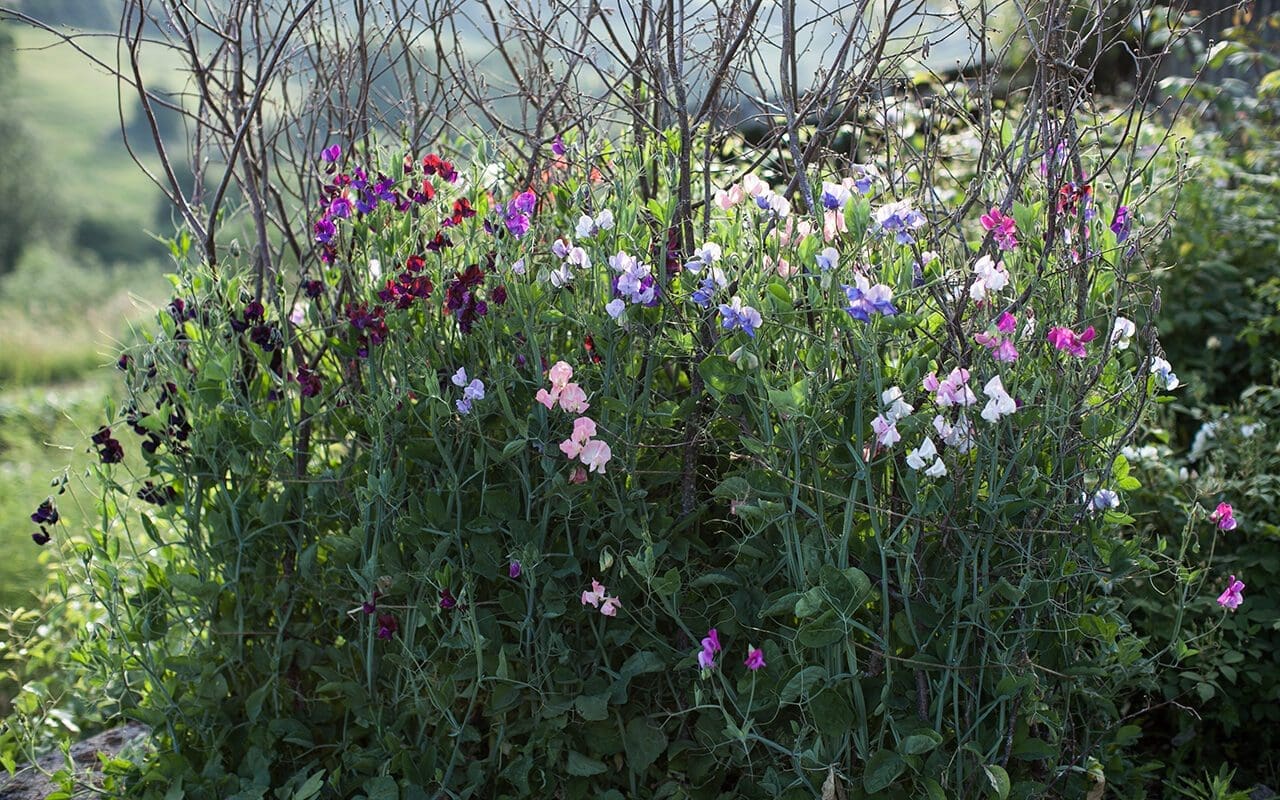
We have grown sweet peas every year since we moved here and have tried a wide range of varieties, but we always return to the Old Fashioneds and Grandifloras. These are the smaller flowered varieties, many of which are very old, and which have the strongest scent. They have a tendency to shorter stems, which means that they are not so popular with flower arrangers and florists, but I simply cut longer stems from the plants with leaves and tendrils intact. The Modern Grandiflora varieties were bred in the 20th century to provide the scent of the old varieties with the larger flowers and longer stem length of the more popular Spencer types, which have large, more ruffled flowers and long stems, but little scent. As with roses there seems little point in growing sweet peas unless they overpower with perfume.
I’ve tried several of the text book methods for prolonging the flowering season, including one year following the wisdom of the professionals and pinching out every single side shoot to encourage upward growth which, when it reaches the top of the hazel poles, is then trained down the neighbouring pole to double the height of the plant and, therefore, the number of flowers it produces. All very educational, but frankly life’s too short. Now I simply ensure that each time I pick a flower (and regular, daily, picking is the best way to ensure longevity) I snip out the side shoot that develops at its base, as the energy required for these prevents the main stem from reaching its full height and the flowers produced on them always have much shorter stems.
Each year we plant a range of colours and, although we have some stalwart favourites like ‘Cupani’, ‘Painted Lady’, ‘Almost Black’ and ‘Lord Nelson’, we always trial some new varieties. Here is this year’s selection.
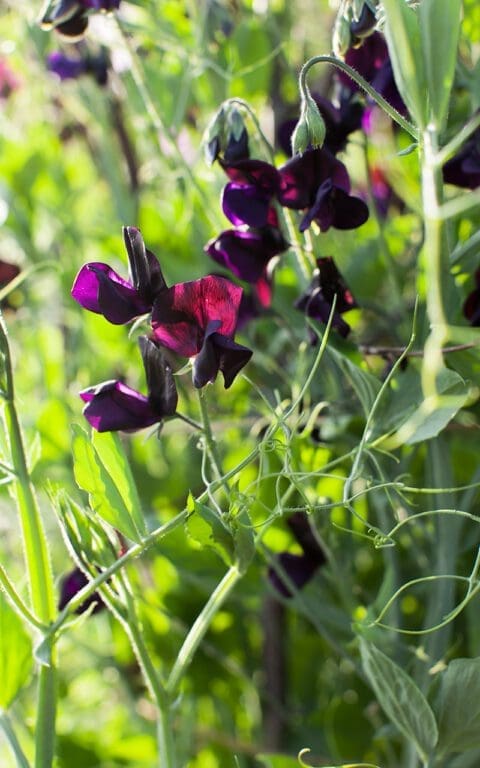
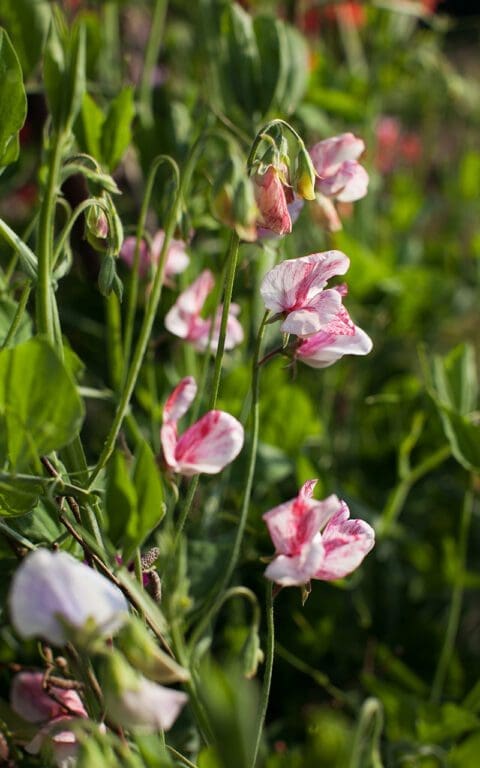
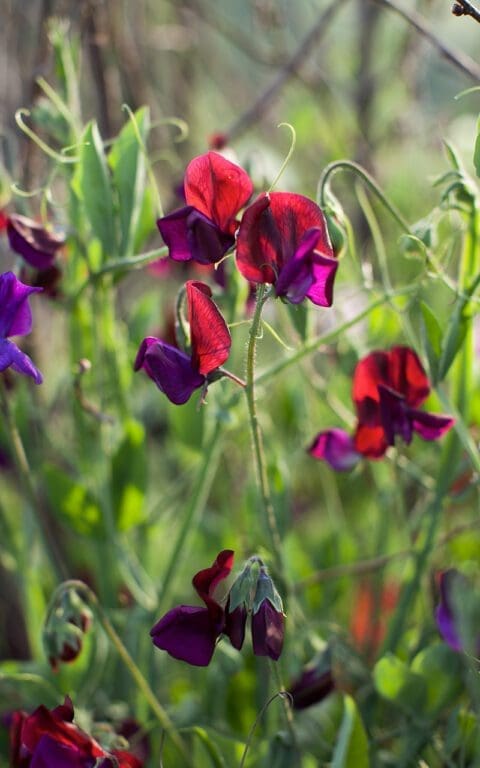
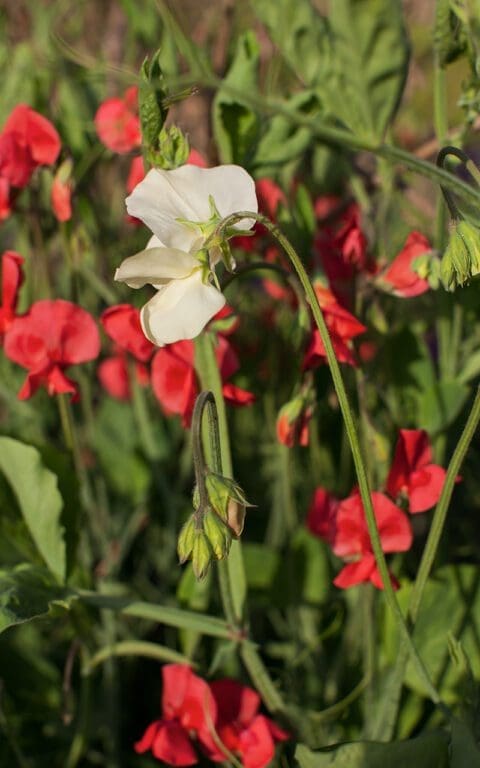
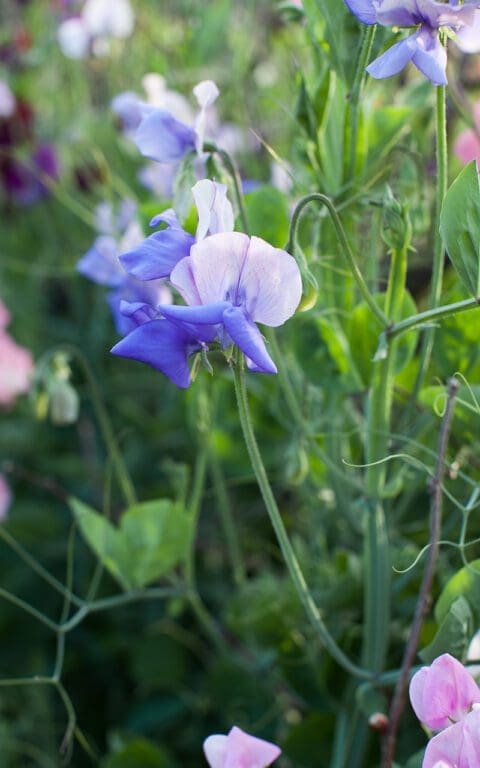
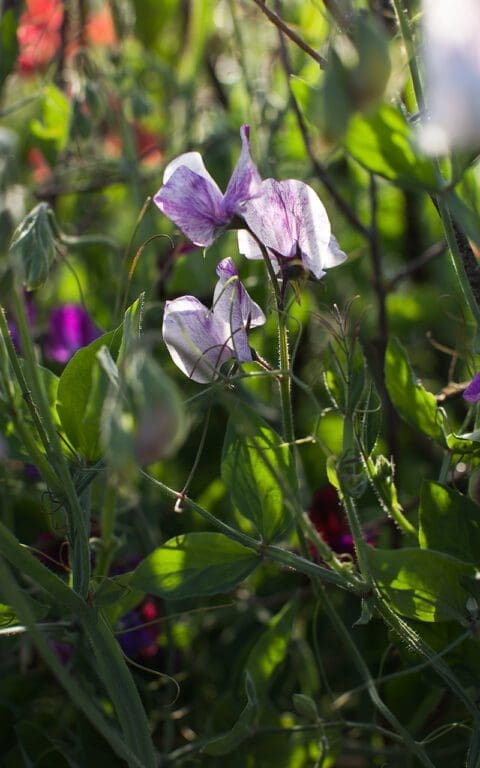
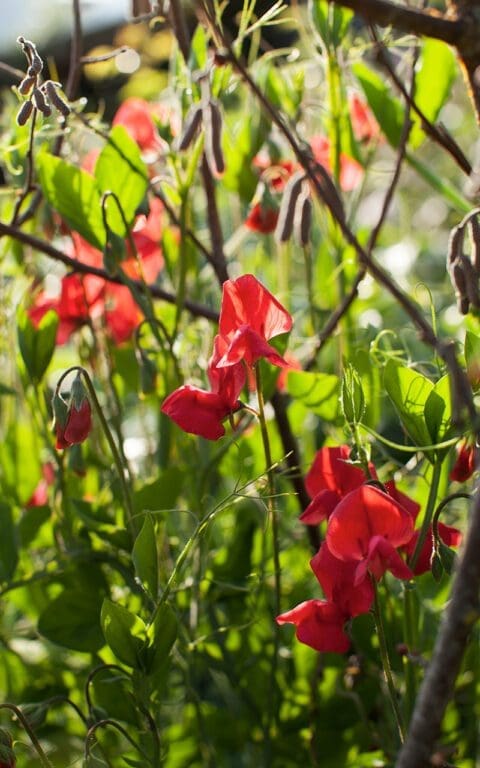
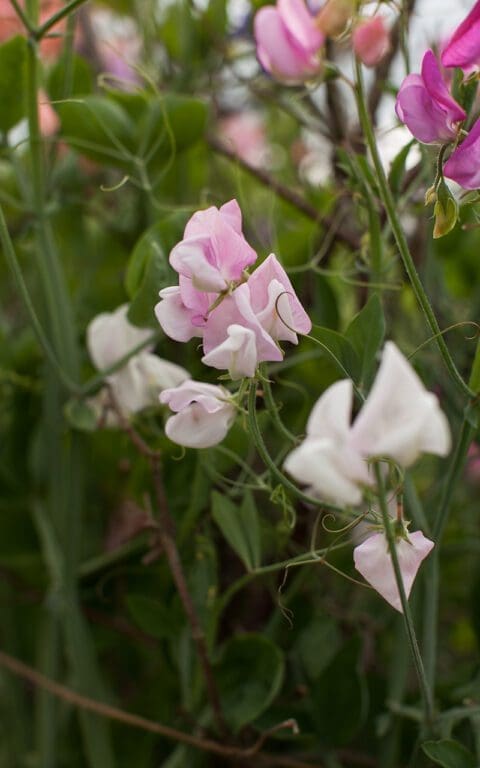
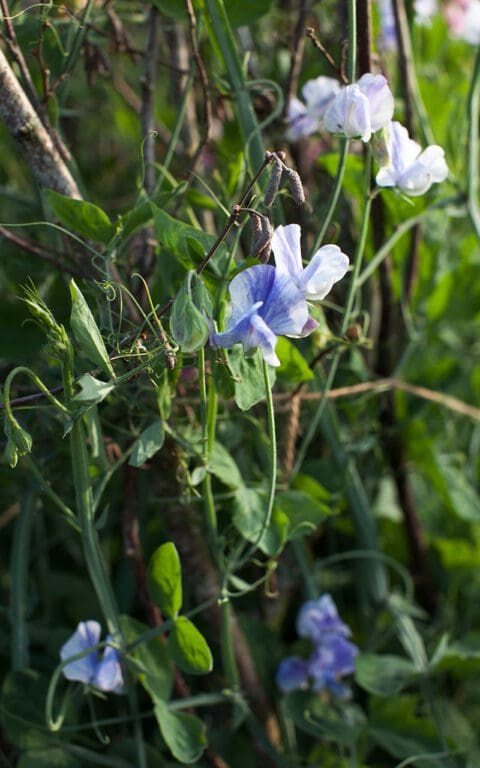
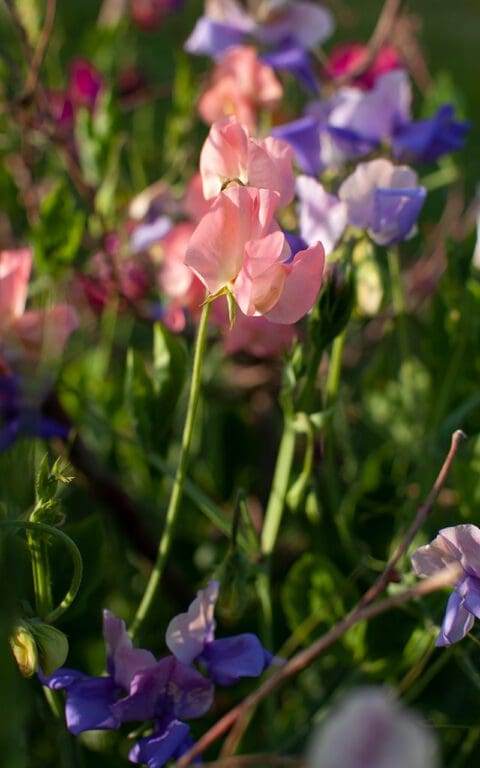
Words and photographs: Huw Morgan
Published 26 June 2021
When we moved here from our Peckham garden with space to try a new plant palette, we set aside a section of the old trial garden to get to know a number of the David Austin Roses. I wanted to live with them day to day rather than vicariously through my clients’ gardens, so I took a trip up to the David Austin rose garden in Albrighton and spent an afternoon in the third week of June in the generous company of Michael Marriott, their rosarian. There is nothing like time spent with experts, or in seeing the plants right there in front of you, each with its own character and, once you had buried your nose in flower, its own perfume. Some spicy, others tangy and smelling of citrus or as fresh and clean as tea.
I had several requirements. I knew I would be using species roses in the wider landscape where they would sit more happily, but for cutting it was important that the roses were good performers and had a long season. I wanted plants that were disease-resistant, because I didn’t want to spray, and it was imperative that they had scent. What would be the point in having a bedside rose that simply sat prettily ?
I came away with a list of twenty four varieties ranging from white through cream and yellow, and then all shades of pink and on into apricot, orange and reds. Most were doubles with quartered blooms, because I wanted to have a little opulence, and it was also important that the foliage had good character. The first plants had five years in the old garden when I dismantled the trial beds to make way for the garden landscaping. At that point I rejected a few that were weak or not right here and replanted with new plants and a few new varieties up by the old barns. I like them here against the corrugated tin, planted in practical rows which suggest and allow for ease of picking.
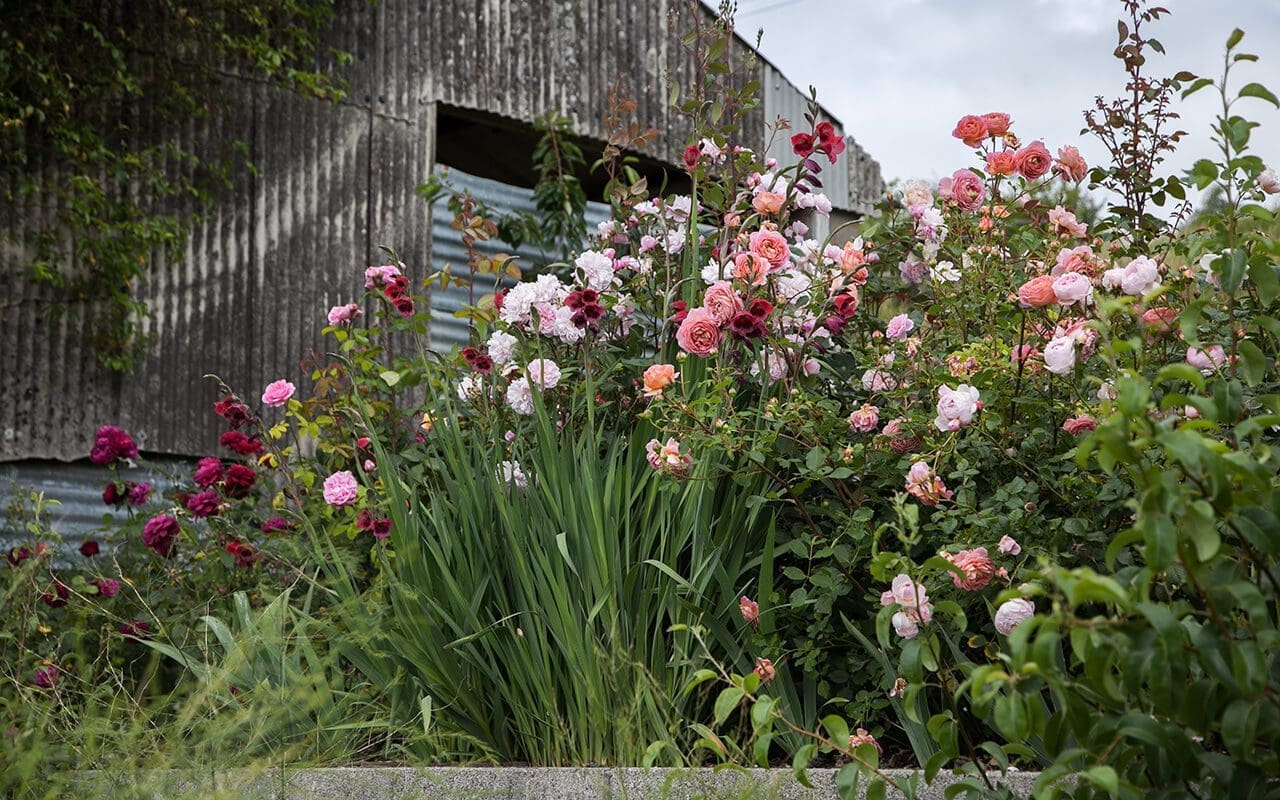
The last nine years here they have shown me what they are made of. In general the yellows have done less well for us, but our West Country climate, with its heavy dews and year round dampness, may be the reason that a few have been prone to blackspot. The beautiful clear yellow ‘Graham Thomas’ succumbed here, though it has done well and been ‘clean’ for friends. ‘Charlotte’ has also failed and neither have been replaced because there is simply no point in having a sick rose when there are a host of others that are strong and healthy. I have struggled to keep a couple of reds and oranges too, but have been happy to spray twice with a sulphur-based fungicide early and mid-season to keep ‘Munstead Wood’ and ‘Summer Song’.
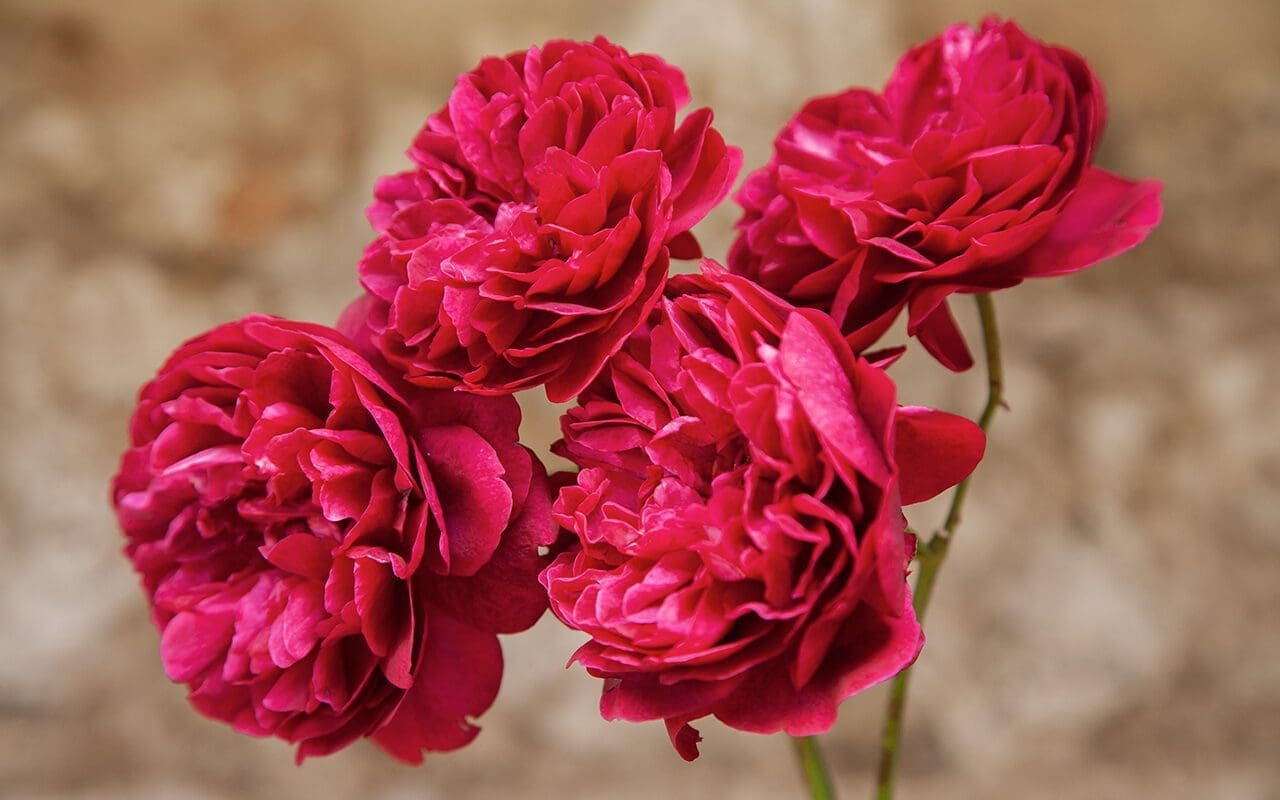
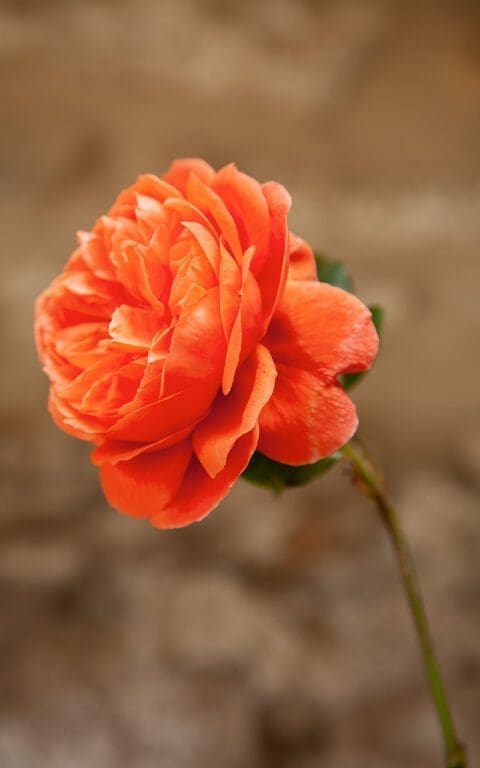
‘Munstead Wood’ is simply the best of the reds, deep and lustrous and beautifully perfumed like your memory of what a rose should smell like. Though not a strong grower, it responds well to being nurtured and I am prepared to do so for the reward. ‘Summer Song’ is perhaps my favourite of all in terms of colour, with a burnt orange flower and delicious zesty perfume. It too is weak and I would never recommend it in a planting scheme, but it can be forgiven for its less than athletic figure in the cutting garden. Cutting the roses regularly is a good opportunity to check on health and vigour. We dead head as we go to keep the flowers coming. I feed with organic chicken manure pellets after their first flush and this helps to keep them in good condition and plentiful right through to November. We have found that the Austin roses take a couple of years to settle in, but are fully up and running in year three.
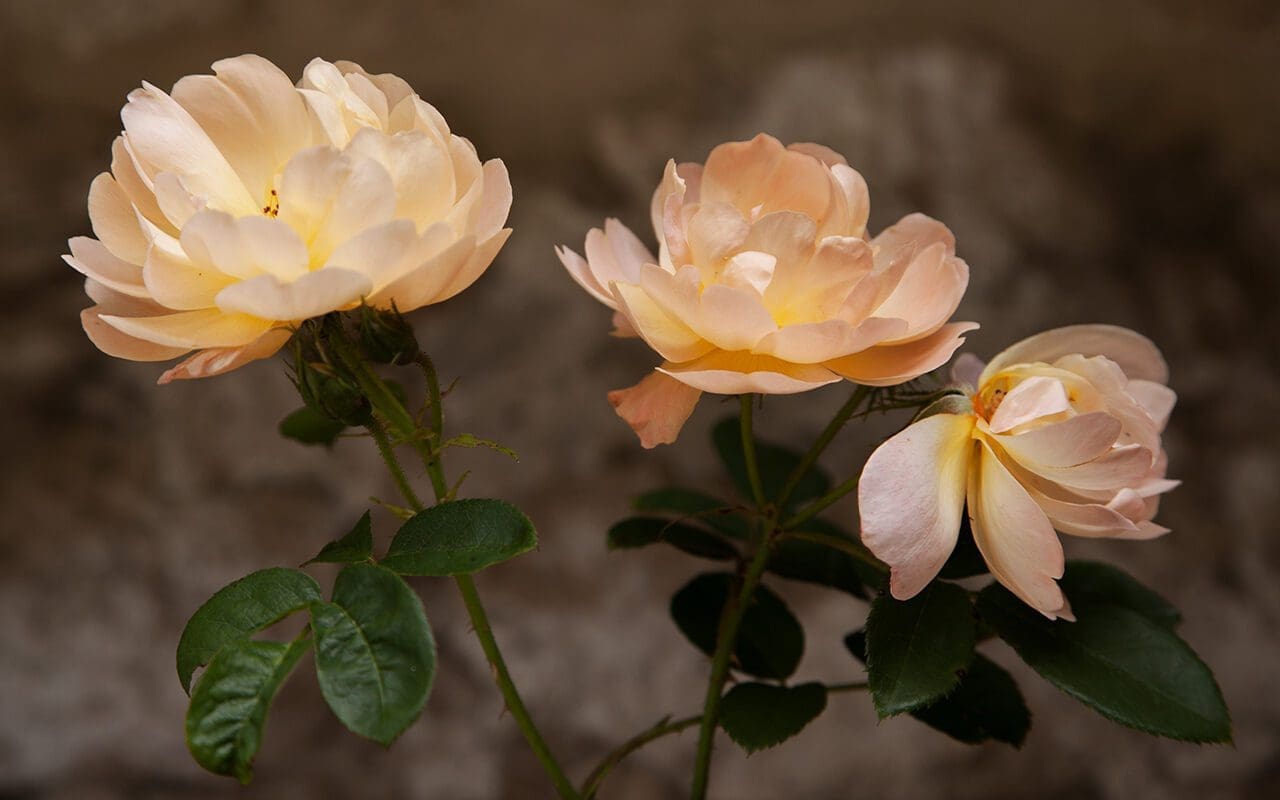
Of those that have done well, ‘The Lark Ascending’ is by far the strongest and a firm favourite. Healthy and amassing a good six feet in a season, the foliage has the mattness of an old-fashioned rose. The flowers are delightful, semi-double, cupping open to reveal a boss of stamens they deteriorating elegantly. The semi-doubles and the singles last less well as cutting flowers but are better for pollinators and this combination of elements make it a good candidate for a mixed planting. The tea-rose scent is delicate, but its habits make it worth this minor compromise.
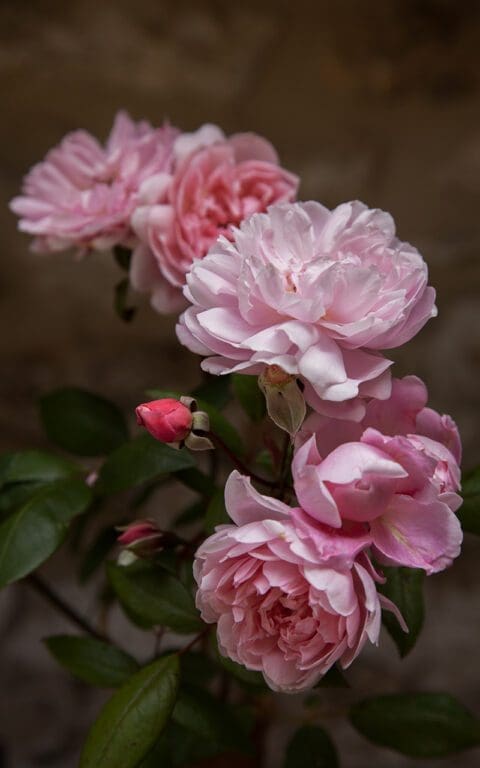
‘Mortimer Sackler’ is also open in character, with loose-petalled, shell pink flowers and an airy personality. Dark stems, delicate growth and fine foliage are more reminiscent of a chinensis rose. The scent is light, but it is a singularly graceful plant. Of all the David Austin roses that we grow, these last two are most relaxed in habit and would be easy in combination with plants like gaura or cenolophium. ‘Mortimer Sackler’ would also take well to being wall-trained.
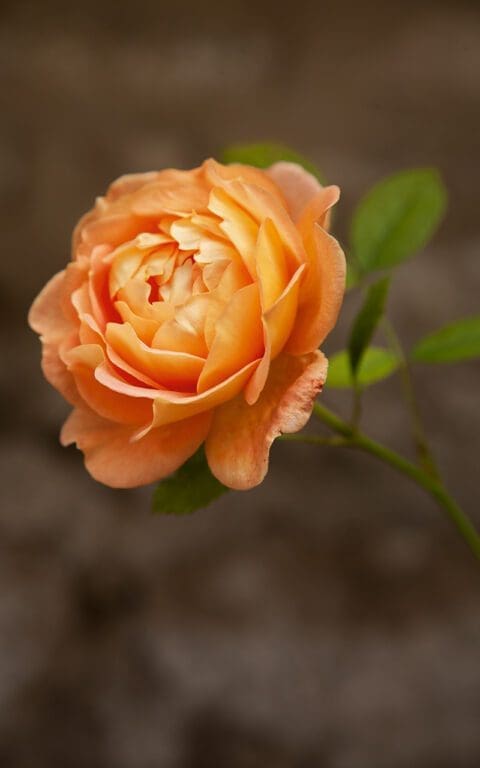
‘The Lady of Shallot’ is one of the best cutting roses, strong and reliable and balanced as a shrub of about four feet. Lasting some time in a vase and beautifully proportioned, the soft orange is easy to use alongside pinks and yellows and its perfume, though recessive, is a fruity tea scent.
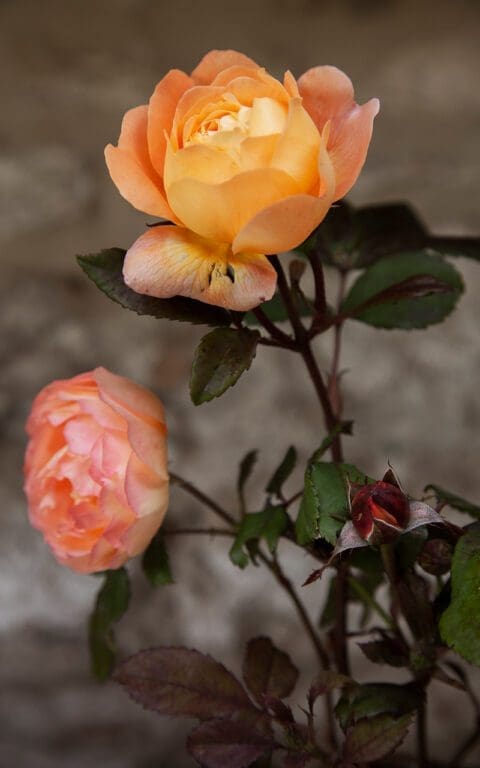
‘Lady Emma Hamilton’ is an excellent, strong-growing plant of similar colour to ‘The Lady of Shallot’, though a little more golden. However, it differs in the dark plum colouring that runs through the new foliage and tints the outside of the buds and then then suffuses the edges of each petal as the flowers age. The overall impression is rich and warm, while the zesty scent is strong and delicious.
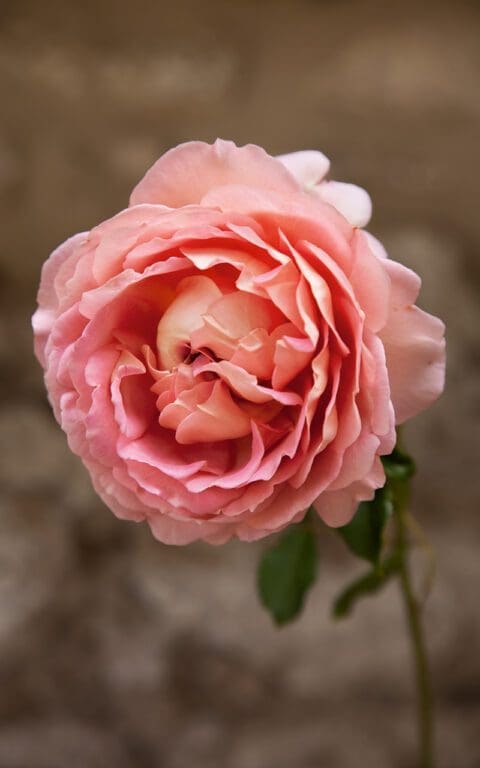
‘Julbilee Celebration’ is an opulent rose and, although the weight of the flower tends to make for a plant that hangs its head (and more so in damp weather), its faded rose colour is unusual. There is enough salmon in it to bridge the pinks, but also a little yellow to act as a mediator between the yellows, apricots and oranges. The scent is proper old rose and, though it is a stiff, stocky grower, I like it immensely once it gets going.
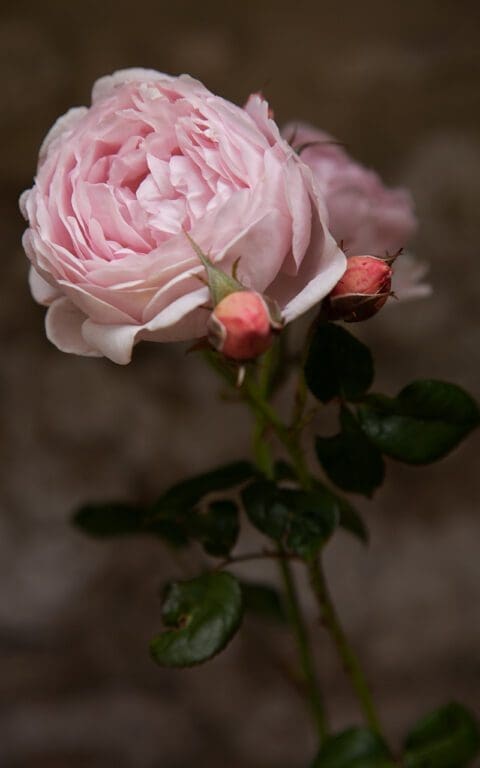
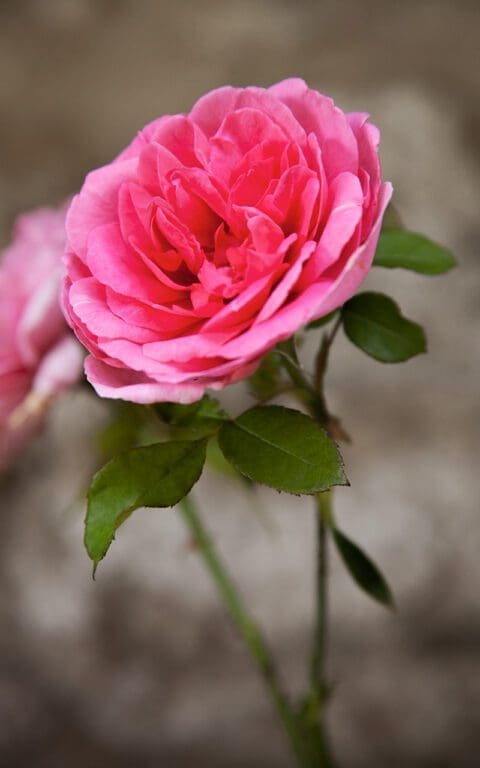
I prefer strong pinks in a garden, campion pink or the electric pink of Dianthus carthusianorum. I do not gravitate towards soft, pale pinks but ‘Scepter’d Isle’ is a good clean pink and a very pretty rose in a bunch, although its scent, described as ‘myrrh’ is hard to pin down. ‘Gertrude Jekyll’ starts a strong deep pink fading as it ages and, although not such an attractive form as others, is by far the best of the roses for perfume. Pure rose and transporting. You only need a bud in a jar to work a room. She is the first of the roses to flower every year and reliable throughout the season.
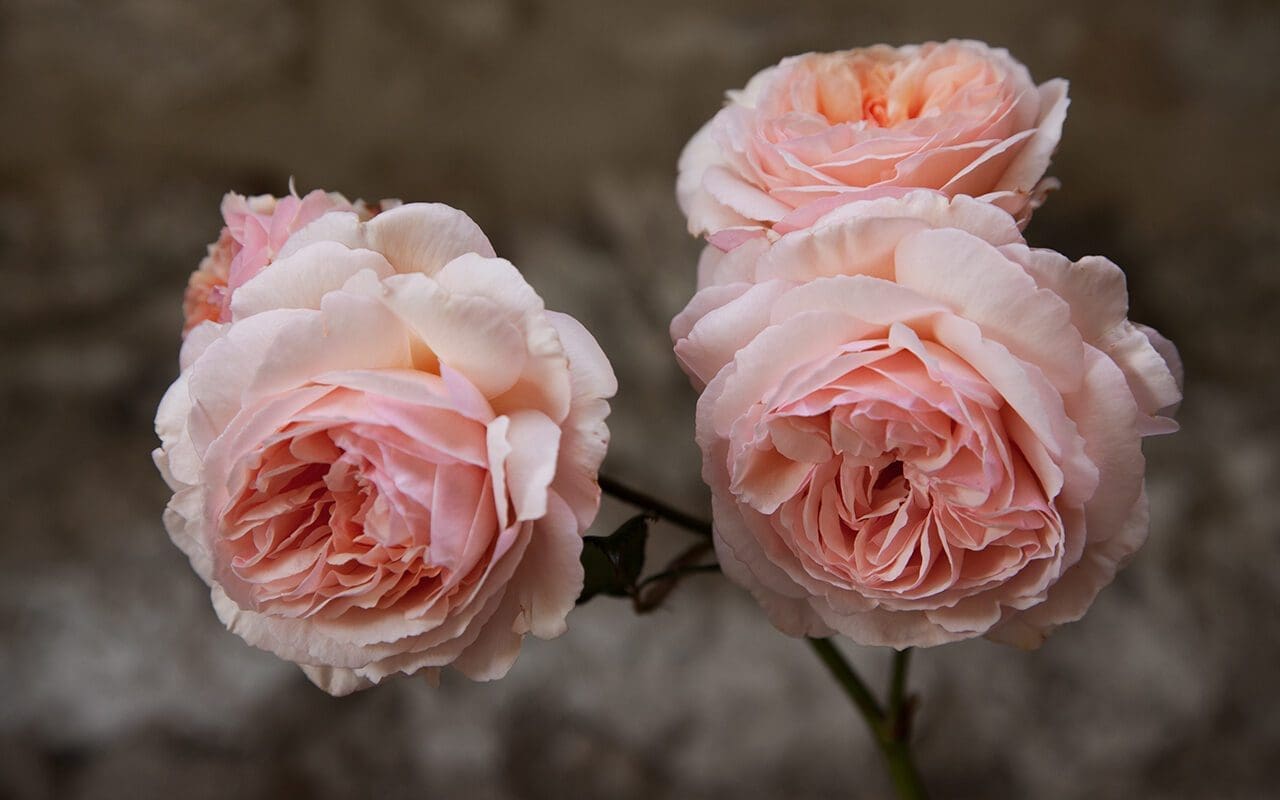
‘A Shropsire Lad’ is by far the most vigorous with limbs that can easily reach six feet in a season and I suspect would make a better climber than a shrub. The flower is fully quartered when it is young, but loosens as it opens, with delicate, creamy flesh tones and a traditional tea rose scent.
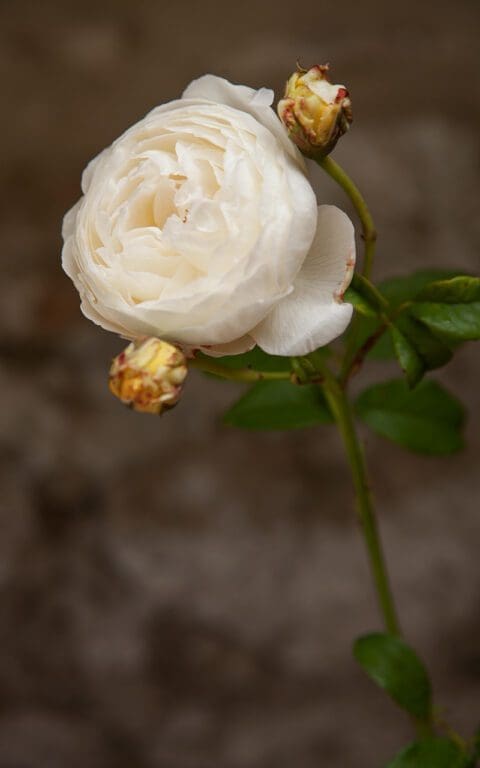
Reaching to eight feet or so the clean, apple green foliage of ‘Claire Austin’ is a fine foil for the creamy white flowers, which are elegant and poised, but do bow gently under their own weight, so it makes for a better climber. I have grown it as such with some success in clients’ gardens, but it also makes a good, rangy shrub that would benefit from some support in a garden setting. The perfume is green and fresh and not remotely heady.
Although we grow two dozen of the extensive Austin range, my aim is to refine down to half that number, slowly letting the ones that reveal themselves to be right for our tastes to gently assert themselves. Cutting is a very nice way to do that. A regular connection and intimacy is always the best way to get to know the keepers.
Main image, left to right: The Lark Ascending, Claire Austin, Munstead Wood, The Lady of Shallot, Jubilee Celebration, Gertrude Jekyll (front), Scepter’d Isle (back), A Shropshire Lad, Lady Emma Hamilton, Summer Song, Mortimer Sackler
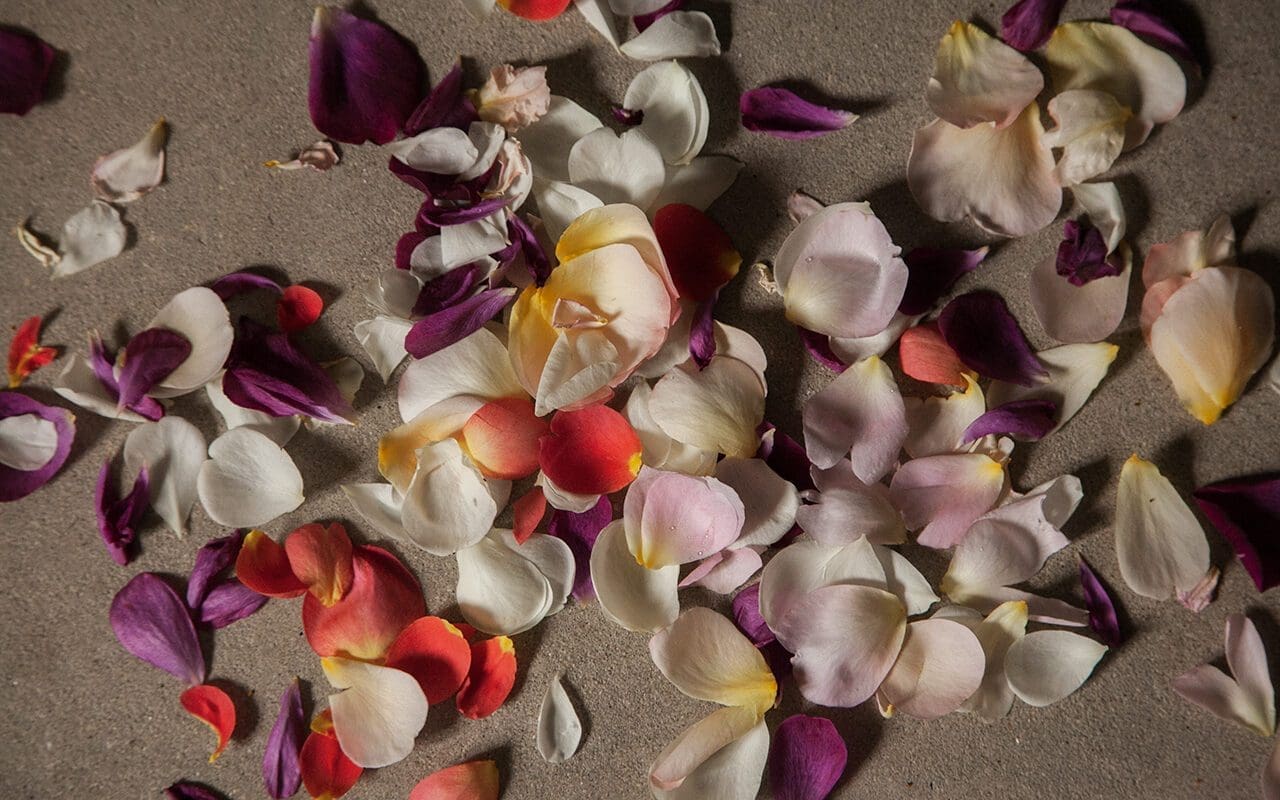
Words: Dan Pearson | Photographs: Huw Morgan
Published 25 July 2020
The sweet peas are an investment. A good one with the promise of marking summertime, but one that is not without a requirement for continuity and a little-and-often attention. The rounded, manageable seed is easy. A finger pushed into compost and three seeds per pot for good measure. Sown either in the autumn and overwintered in the frame for a little protection for the strongest plants and earliest flower or, alternatively, at the first glimmer of spring in February. You have to watch if the mice are not to eat the freshly sown seed before it has even germinated and, although perfectly hardy, they like good living once ready to go out in April. They require good ground, with manure or compost and plenty of moisture to send their searching growth up into a carefully managed cage of supports. We use hazel twiggery from the coppice here. Helping their ascent, so that their soft tendrils are trained within easy reach for picking, another part of the daily vigil. And finally, once they start to bloom, you need to keep on picking to keep the flowers coming if they are not to go to seed.
All in all the rewards are forever worth it and the jug sitting beside me, with the whole room perfumed of summertime is testament. Their vibrancy is the personification of long days spent outside doing and the elongated evenings that stretch ahead until bedtime. We spend this valuable time looking and find the evenings and early morning the best time to pick them, for the cool flushes their flower and helps in keeping for longer. The evening bunch for the bedside and the morning bunch for the kitchen table. Pick and you can keep on picking every other day and, when the plants finally begin to run out of energy in August, you will be sure to feel the next season coming. The weight of harvest and in the case of the Lathyrus, the desire to go to seed, which we make allowance for when the stems get too short to pick so that we can save some.
We grow two batches of sweet peas now. Named varieties of the Old Fashioned sweet peas, which we buy new every year from Roger Parsons and Johnson’s. Selected for their perfume and not length of stem we grow them up informal hazel wigwams in a strip of land we call the cutting garden. These are an ever-changing selection as we add to and subtract from a variable list as we move through new varieties and revisit ones we’ve grown to love. These selections have plenty of Lathyrus odoratus blood coursing through their veins and we like the fact that you can feel the parent and that they have not been overbred at the expense of their stem length, flower size or perfume.
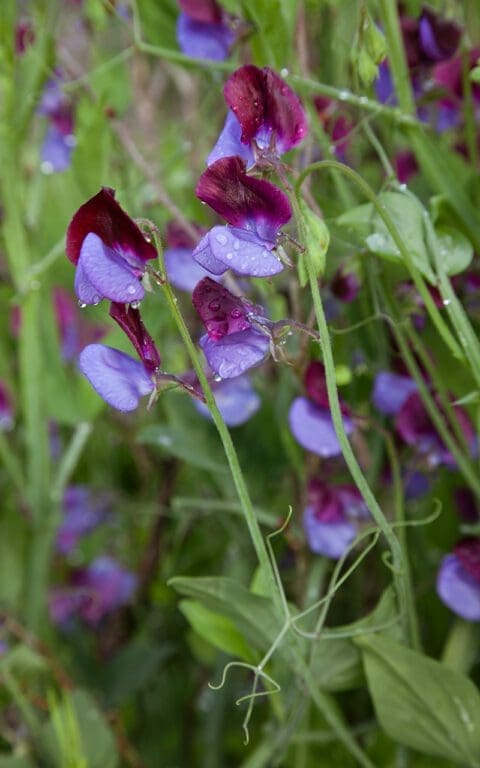
Set to one side and grown amongst the perennials in the main garden are the pure Lathyrus odoratus. We keep them apart because the seed was collected by the plantsman and painter Cedric Morris on one of his journeys to Sicily. The direct line has been carefully handed down to custodians who knew the importance of continuity. First, directly from Cedric to his friend Tony Venison, former Gardens Editor of Country Life, and then from Tony to his friend Duncan Scott. Meeting Duncan was a chance happening, as he is the neighbour of a client who thought we should connect. Duncan knew of my friendship with Beth Chatto, who in turn had learned directly from Cedric and had many of his plants in her nursery.
Duncan’s seed was handed over in a brown paper bag with the inscription ‘Cedric’s Pea. Lathyrus odoratus, collected in Sicily’. In turn I have recently had the pleasure of sending seed on to Bridget Pinchbeck who has taken on the responsibility of restoring Benton End, Cedric’s house and garden in Suffolk, to become a creative outpost of The Garden Museum. A full circle made in not too many leaps of the gardeners’ weave and easy generosity.
I am very happy to help keep the line alive and to pass it on, as we have spent much time looking through Cedric’s eyes over the years. First with plants that Morris gave with stories of their provenance to Beth Chatto and her in turn to me. And then through his dusky almost-grey and pink selections of Papaver rhoeas and latterly his Benton Iris which we grow here and treasure. Lathyrus odoratus was first introduced in 1699 by the monk Francis Cupani, the name which you will often find the pea listed under. I wonder whether Morris made his trip to Sicily in Cupani’s footsteps to find the pea for himself ? Regardless, it is good to imagine the find and relive his undoubted excitement at it. The vibrancy of the flower, with its vivid coupling of purple falls, wine red standards and the halo of unmistakable perfume.
It is Cedric’s lathyrus which is the first of our sweet peas to flower. A whole two weeks earlier than the named varieties and still the most perfumed of all. When we walk the garden in the late half-light of June, it is with an invisible orbit of scent that stops you on the path. The late light or early morning are the best times to see their colour. Clear and sumptuous and well worth the effort of continuity.
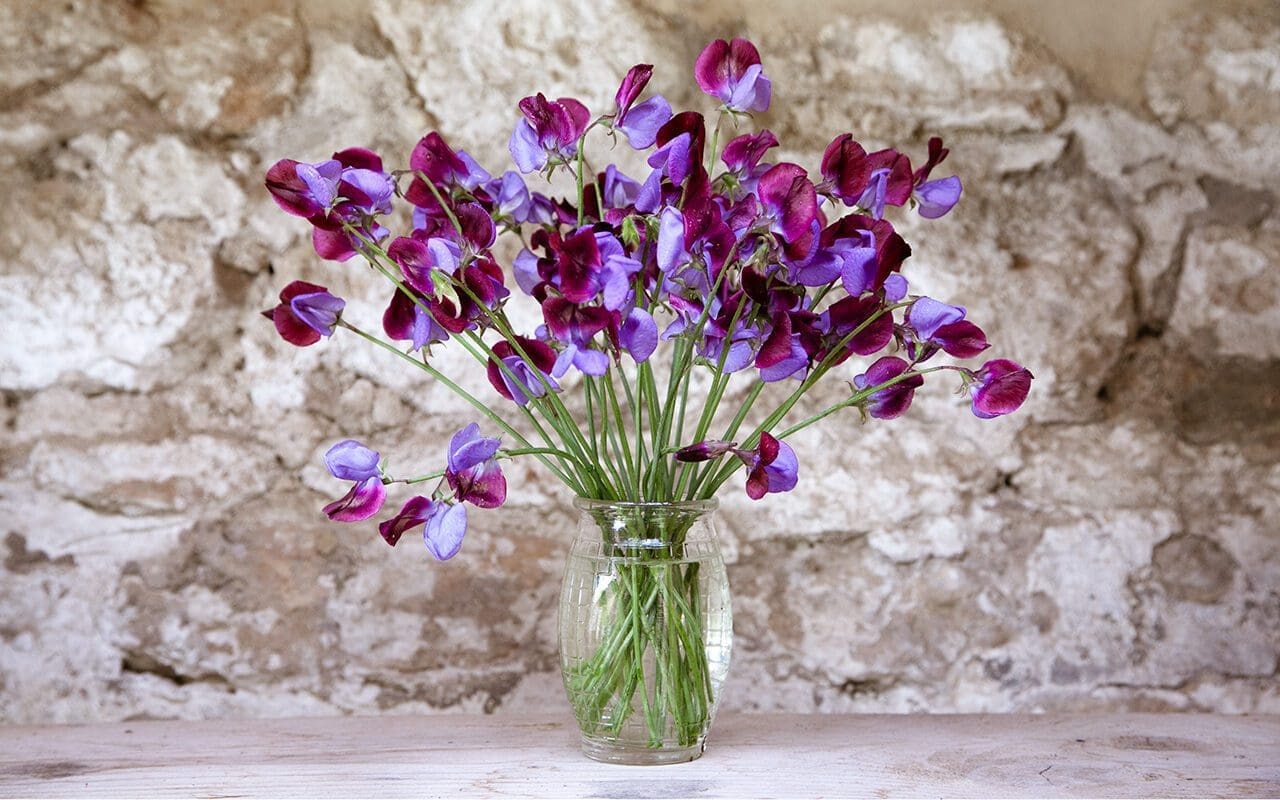
Words: Dan Pearson | Photographs: Huw Morgan
Published 19 June 2020
When we arrived here the smallholding aesthetic, with its ad hoc manner of making-do, ran right up to the buildings to keep anything growing at bay. A brutal concrete slab sloping down and away from the lane surrounded the end of the house, diving steeply between it and the little barn below, where the cows were once milked, to form a yard. From there more concrete ran along the field before climbing steeply again towards the big barns, where the troughs now screen the kitchen garden from the house.
The track had been made in sections, as and when materials were available and potholes needed filling, so your first experience as you arrived off the lane was dominated by negotiating this necessary evil. You either had to park your car at an angle that spilled the contents when you opened the doors or prepare yourself for a vertiginous descent if you drove down into the yard. You certainly weren’t getting back up easily if the weather turned in the winter.
We muddled on for the first five years of being here and partly liked the authentic feeling of it, but I knew that it would eventually have to go so that the house could be cushioned in green again and not divided from it. After we renovated in 2016, we removed the concrete and reoriented the track behind the buildings and built a level platform at the end of the house. Flat ground is limited here, but even the smallest amount helps you to feel grounded enough to lift up your eyes and take in the view.
I wanted this pull-in from the high-hedged lane to be a little breathing space, to not give too much away of what was to come and to welcome you into an eddy, a pause with a feeling of rightness. I planted black-catkinned willow to form a semi-permeable boundary, so that you only got glimpses of the garden beyond and encouraged Erigeron karvinskianus, Centranthus lecoqii and white linaria to self-seed in the gravel. Viola odorata, which doesn’t mind the exposed position because it has company, reappears when the Mexican daisy is dormant in winter and when the sun shines in February they liberate their perfume to catch you unawares .
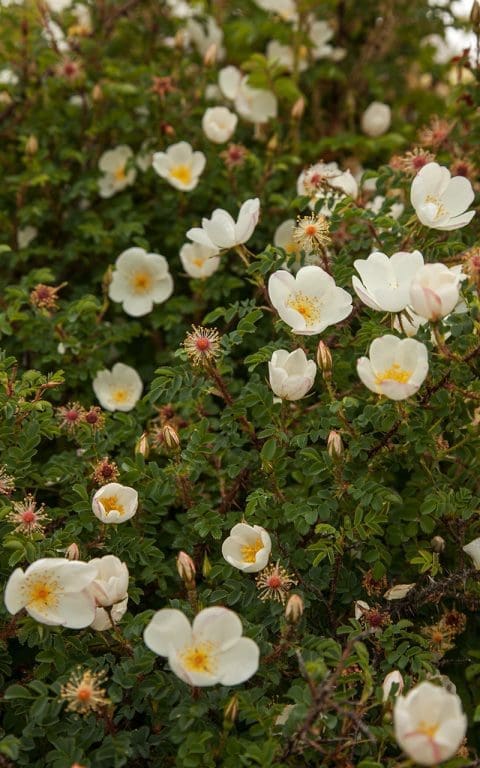
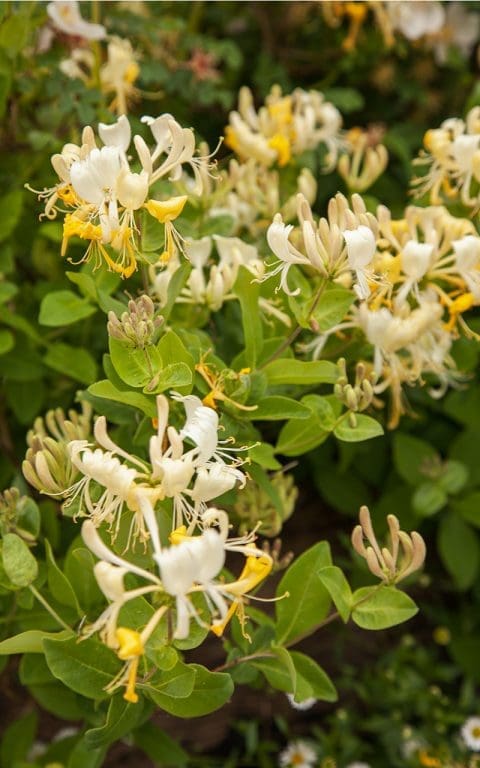
Perfume was an important consideration for this first impression and a scented ambush shoulders your descent down the steps to the front of the house. A seed-raised Rosa spinosissima, which we collected from Oxwich Bay on the Gower peninsula, sits to one side and hunkers down to form a little thicket. The first flowers opened in the last week of April this year and, although the perfume is delicate, it is delicious when you catch it for the month the bush is in flower. I’ve been training a honeysuckle along a log we’ve used to define the edge of the entrance platform, but now the briar is large enough I’m letting the two intertwine. The honeysuckle is a selection of our native Lonicera periclymenum called ‘Scentsation’. It’s not the best of names, but I have not seen a form that flowers as freely or grows as compactly. And it does live up to its name, perfuming the air sweetly and causing you to stop and linger when the wind stills in the evenings.
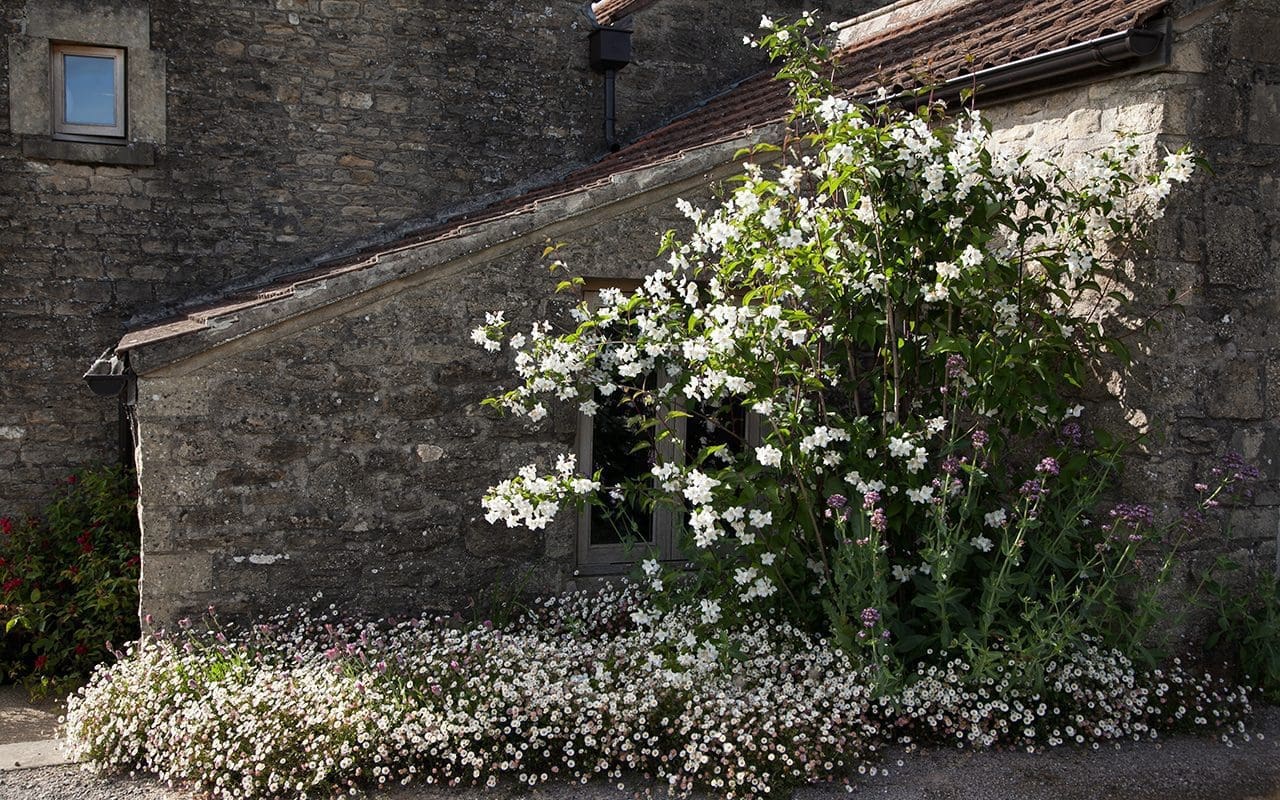
The second perfumed shoulder by the steps, held in the angle of the building to the other side is Philadephus ‘Starbright’. In its third year and beginning to have enough impact to create a presence here, we now have enough flower to perfume the breeze. In terms of scent, mock orange is a perfect description and is placed for best effect so that the wind blows it towards you. I don’t expect it to get much taller than it is now, topping out at about eight feet and six or so across for this P. delavayi x lewisii cross is modestly sized. The larger growing Philadelphus coronarius is beautiful in June with clouds of fugitive blossom but, for the remainder of the year, they are not the most interesting of shrubs.
‘Starbright’ has an open habit, never heavy, is upright but not stiff and remains open. Though it also settles into a quiet shrub for the rest of the summer, it is good in the lead up to flower, pushing plum coloured growth and first foliage. The dark staining travels into the calyces of the flowers which, against their brilliant, pure white, appear as dark as if they had been charred. Now that our ‘shoulders’ are large enough to spare some for the house, this week we have been picking combined bedside posies of mock orange and honeysuckle. Both have a fresh, zesty perfume, but the philadelphus is easily distinguished in a posy. It is evenly scented both day and night, while the honeysuckle is strongest after dusk and through into early morning. It has been waking me throughout the night, breaking my sleep with waves and pulses of perfume. I like the thought of it seeking the attention of night time pollinators and am happy that we now have enough to bring into the house to feel the full benefit ourselves.
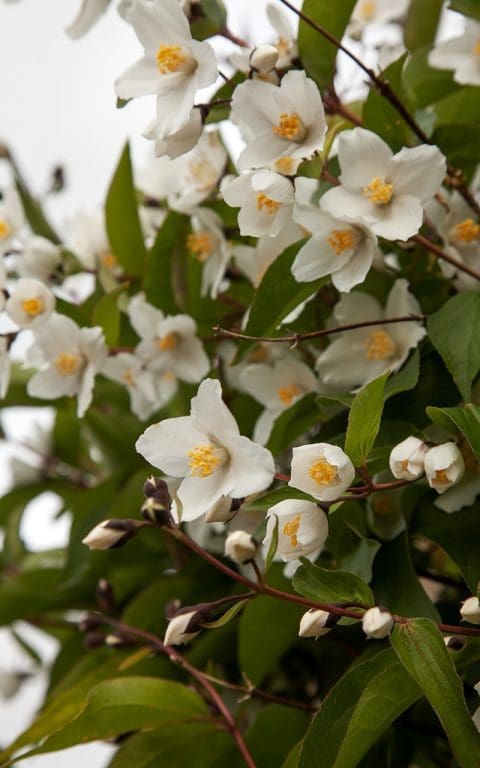
Words: Dan Pearson | Photographs: Huw Morgan
Published 23 May 2020
The garden has taken a distinct and irreversible turn. It is not a sad thing, just the beginning of another season. A slowness in the Morning Glories, that just a fortnight ago were still racing skyward and now stay open well into the afternoon in defiance of their name. Kaffir lilies flaring hot colour and the first spears already pushing on the Nerine.
A gentle countermovement happens alongside the feeling that most things have reached their peak and are now ready to begin standing down. When we lived in London it was the Datura which went for its best and most intoxicating September fling. Primed by the cooling weather and definitely responding to the onset of autumn, it had been readying itself for such a finale, which, in the shelter of our Peckham garden, would run through to November and test my resolve in leaving the plant out just for one more night. I have an offspring of the very same plant here, treasured but never thriving on our windy hillside. Though I have moved the pot around to try and find it the shelter it needs, this hothouse flower knows its limits and taunts me here rather than rewarding.
Not so the Nicotiana suaveolens which right now is having a moment. This is another plant that I have grown continually for what must be at least twenty years. I first knew it as Nicotiana noctiflora, in reference to its night-flowering habit, and have a niggling half-memory of where it originally came from, which is surprising considering my devotion. Derry Watkins of Special Plants was here recently and said that it was one of her all-time favourites too, but that she never saw it any more. She used to grow it for sale, but the plants were seldom bought. When I asked her why, she said that she thought it was too subtle for most people. Its quiet elegance is exactly why I love it.
I have explored the tobacco plants over the years. Towering Nicotiana mutabilis, with a confetti of tiny flowers, suspended in a cage of branching stems, which age from white through palest pink to deep rose. Where there has been a need for an exotic moment, Nicotiana sylvestris has provided lush foliage, a bolt of white drama and heady perfume. The tiny, green bells of Nicotiana langsdorfii have been mingled amongst perennials to extend the season in the borders and I currently have a little trial of dark-coloured varieties, which I imagine must have some N. langsdorfii in their blood. ‘Tinkerbell’ has lime green trumpets with a rust-ruby face and unexpected blue pollen. ‘Hot Chocolate’ is similar, but a velvety brown-red. Subtle beauties that need to be placed carefully if their colour is not to be lost.
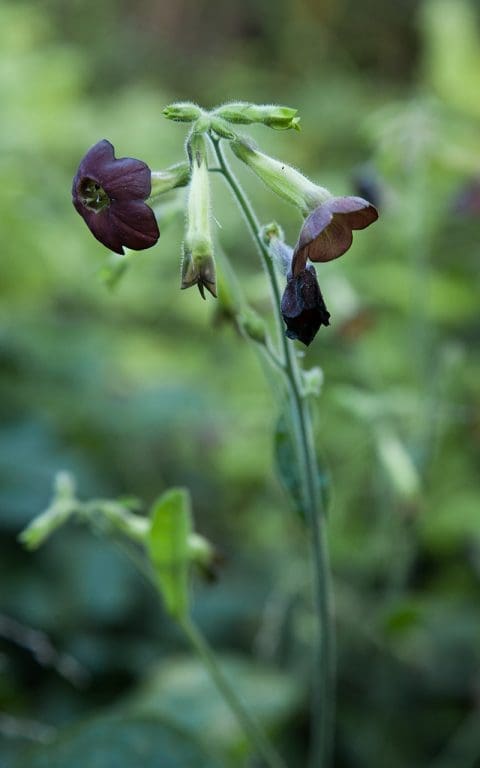
In Peckham we suffered from the dreaded tobacco mosaic virus, which is carried on tomatoes and affects their solanaceous cousins when in full swing. When it hits, the Nicotiana leaves firstly develop the distinctive mosaic patterning, then they begin to twist and melt, leaving the plants failing in high season with a wide open autumn ahead of them and the associated disappointment. Interestingly, the Australian Nicotiana suaveolens was never affected and, even when growing alongside others that did succumb, it soldiered on until the frosts. I brought it here as seed, which is produced in plenty and is easily reared from a March sowing under glass. Where it has seeded into pots that spend their winter in the frames, I’ve found it to germinate spontaneously in April as the weather warms. The seedlings that make their own way without transplanting catch up with those that are pricked out and cossetted.
In London our plants would return for a second and sometimes even a third year if their spring regrowth wasn’t decimated by slugs. Though I plant out a dozen or so as gap fillers close to the paths, we have too much winter here, but our most splendid plant is growing just under the eaves of the open barn. I presume the ground is dry enough in winter to afford it enough protection to have returned a second year and at twice the size from the reserves of a decent set of roots. I noted the frosted rosette looked green in March when winter turned and looked after it accordingly to guard it from slugs.
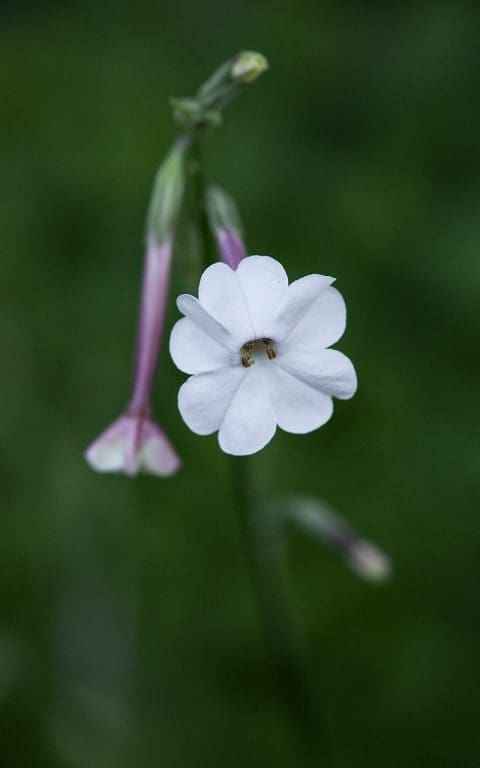
Our barnside plant has been gathering in strength over the summer, pushing out flower since July. The wiry stems set the long trumpets free of the basal foliage and the flowers appear with room between them to hover. During the day, from mid-morning onwards, they hang in repose so that you hardly notice them, but as evening descends they awaken. Part of their nocturnal glory lies in their paleness, which is luminous in darkness and this is when they throw out their lure, pulsing perfume to attract moths and other night time pollinators. When we returned from London on Thursday night, the misty air was still and the open barn had captured this heady, exotic perfume. A smell reminiscent of cloves and jasmine that conjures somewhere very different from our cool, dampening autumn.
Words: Dan Pearson | Photographs: Huw Morgan
Published 14 September 2019
The hamamelis have burst their tight, velvety buds. Huddled darkly along bare branches, it is as if they have waited until we are hungry, our appetites pining for a break with winter. Welcome for the absence of life elsewhere, I fall under their spell again yearly, without fail and willingly. I first encountered them in maturity at Wisley, where in winter they were a mainstay of the winter plant idents, but it was not until my early twenties that I saw the true potential of the witch hazels. My friend Isabelle had taken me to Kalmthout Arboretum in Belgium to meet the owner, Jelena de Belder, the grower of many witch hazels and breeder of several of the best. The first, ‘Ruby Glow’ amongst them, were planted at the arboretum in the 1930s and the De Belders started their own breeding programme in the ’50’s. By the time we saw her collection in the early eighties, they were reaching out in maturity to touch one another, their fiery limbs, on a deep February winter’s day, an unforgettable understorey. The branches were bare and filled with the light of a million tiny filaments. The darkest as deep and red as rubies, and from there running through fire colours from the glow of smouldering embers to incandescent gold, flame yellow and palest sulphur. Writing now with a sprig of ‘Barmstedt Gold’ on the table in front of me, so that I can look in close detail, I remember further back to Geraldine’s Hamamelis mollis. Our neighbour, and my gardening mentor when I was a child, always picked a sprig to enliven her winter table. We would marvel at the strength of the perfume and its combination of delicacy and brazenness pitted against the odds of winter. So my witch hazel affair goes far back, but now is the first real opportunity I’ve had to put a shrub in open ground and be happy in the expectation of its future.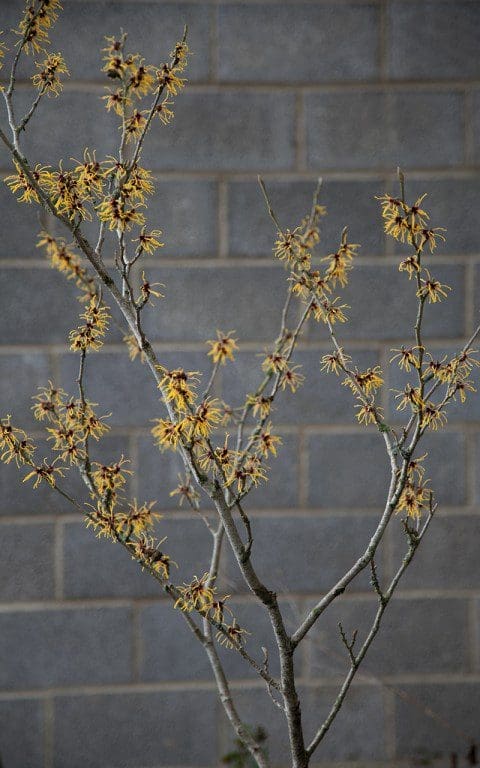
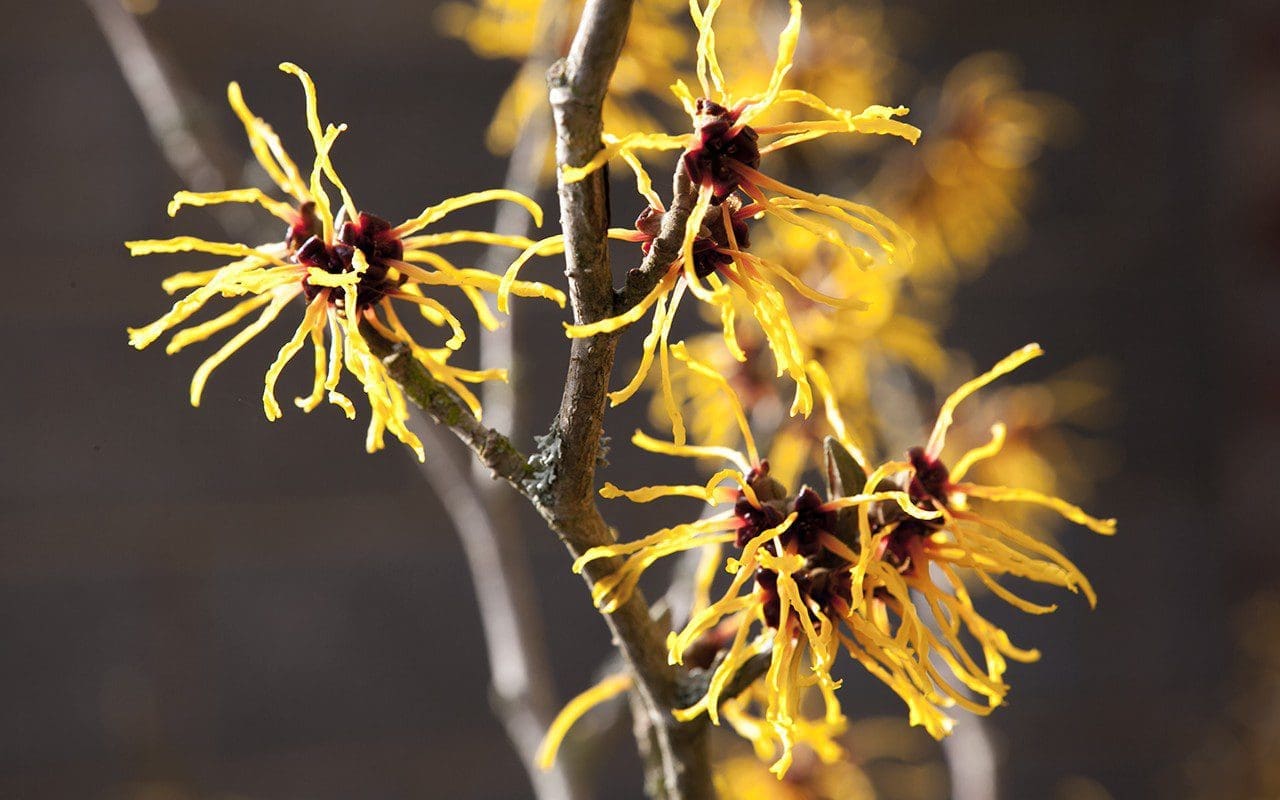 Hamamelis x intermedia ‘Barmstedt Gold’
Hamamelis x intermedia ‘Barmstedt Gold’
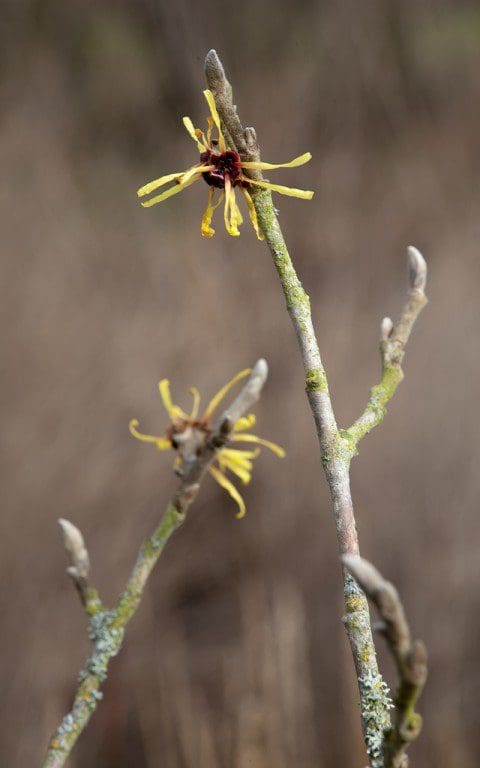 Hamamelis mollis
Before here, in the Peckham garden, I grew hamamelis in pots, because there simply wasn’t space in the beds. They were surprisingly tolerant and it afforded me the opportunity of bringing them up close to the house in the winter to watch their buds unravel at close proximity. ‘Jelena’, a soft orange Hamamelis x intermedia hybrid named after Mme. de Belder, was always the first to flower, before Christmas in London and running through the length of January. It outgrew me, its limbs reaching wide and elegantly in a stretch that became harder and harder to accommodate when I moved it back into the semi-shade at the end of the garden. In the end I gave it away to Nigel Slater when creating a secret garden for him. A good home where I knew he would enjoy it, and every year I am delighted to see him post pictures of the first flowers on Instagram.
H. x intermedia ‘Gingerbread’ (main image) and ‘Barmstedt Gold’, together with a plant of Hamamelis mollis, a gift from Geraldine, came with me from Peckham to here in pots. The intermedia hybrids produce the greater bulk of the coloured varieties but, though they are scented, not all have the pervasive scent of the straight H. mollis. It is often something you have to find and put your nose to, which is why it is worth placing them in a sheltered corner which will hold the perfume, or upwind of where you know you are going to pass. Growing most happily in open woodland, they are adaptable to being out in the open as long as their roots are kept cool and moist in the summer months, and will flower more heavily in the light. Scorched edges to the foliage will show you that they have been under stress and if, like me, you have no choice but to grow them in an open position, this can be alleviated with a summer mulch and long, deep watering when it gets dry.
The books will tell you that they prefer acid soil, but I have found them to be tolerant of alkaline conditions, as long as they have plenty of organic matter in the ground, do not dry out in summer nor lie wet in winter. However, what few books tell you is that they can be short-lived if they find themselves under stress. A tree of thirty years is doing well if you force them too far beyond their comfort zone. They are also slow to attain size, or feel slow because you have an image of wide-spreading limbs in your mind, not the stark twiggery of a young plant. In five to seven years you can begin to see the plant as you want it to be, but if you spend a little more than you’re comfortable with, seeking out a 10 or 15 litre plant that has some substance, the immediate payback is worth it. This year’s purchases – I find it very difficult to resist extending my experience of witch hazels – saw the instant benefits of a waist high ‘Aphrodite’ for nearly £40 and a twig of ‘Orange Peel’ for £15.
Hamamelis mollis
Before here, in the Peckham garden, I grew hamamelis in pots, because there simply wasn’t space in the beds. They were surprisingly tolerant and it afforded me the opportunity of bringing them up close to the house in the winter to watch their buds unravel at close proximity. ‘Jelena’, a soft orange Hamamelis x intermedia hybrid named after Mme. de Belder, was always the first to flower, before Christmas in London and running through the length of January. It outgrew me, its limbs reaching wide and elegantly in a stretch that became harder and harder to accommodate when I moved it back into the semi-shade at the end of the garden. In the end I gave it away to Nigel Slater when creating a secret garden for him. A good home where I knew he would enjoy it, and every year I am delighted to see him post pictures of the first flowers on Instagram.
H. x intermedia ‘Gingerbread’ (main image) and ‘Barmstedt Gold’, together with a plant of Hamamelis mollis, a gift from Geraldine, came with me from Peckham to here in pots. The intermedia hybrids produce the greater bulk of the coloured varieties but, though they are scented, not all have the pervasive scent of the straight H. mollis. It is often something you have to find and put your nose to, which is why it is worth placing them in a sheltered corner which will hold the perfume, or upwind of where you know you are going to pass. Growing most happily in open woodland, they are adaptable to being out in the open as long as their roots are kept cool and moist in the summer months, and will flower more heavily in the light. Scorched edges to the foliage will show you that they have been under stress and if, like me, you have no choice but to grow them in an open position, this can be alleviated with a summer mulch and long, deep watering when it gets dry.
The books will tell you that they prefer acid soil, but I have found them to be tolerant of alkaline conditions, as long as they have plenty of organic matter in the ground, do not dry out in summer nor lie wet in winter. However, what few books tell you is that they can be short-lived if they find themselves under stress. A tree of thirty years is doing well if you force them too far beyond their comfort zone. They are also slow to attain size, or feel slow because you have an image of wide-spreading limbs in your mind, not the stark twiggery of a young plant. In five to seven years you can begin to see the plant as you want it to be, but if you spend a little more than you’re comfortable with, seeking out a 10 or 15 litre plant that has some substance, the immediate payback is worth it. This year’s purchases – I find it very difficult to resist extending my experience of witch hazels – saw the instant benefits of a waist high ‘Aphrodite’ for nearly £40 and a twig of ‘Orange Peel’ for £15.
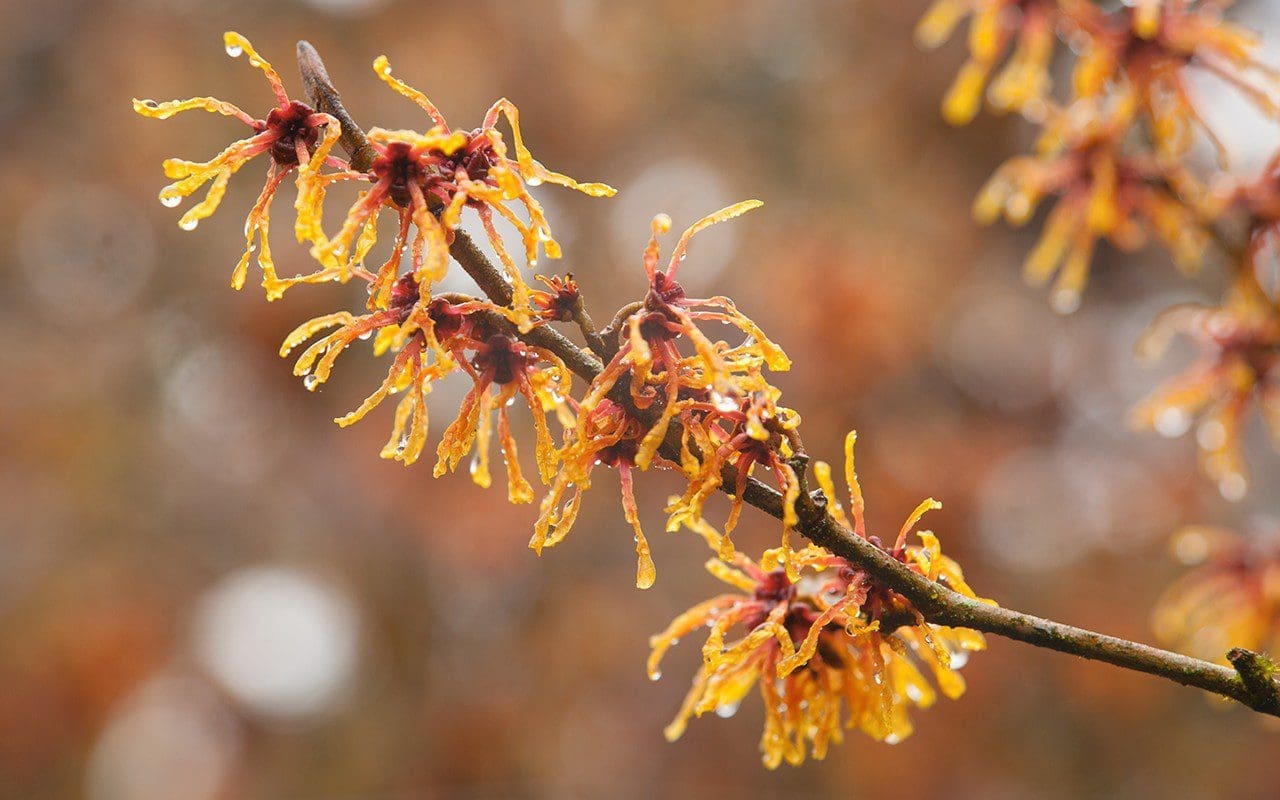 Hamamelis x intermedia ‘Aphrodite’
Hamamelis x intermedia ‘Aphrodite’
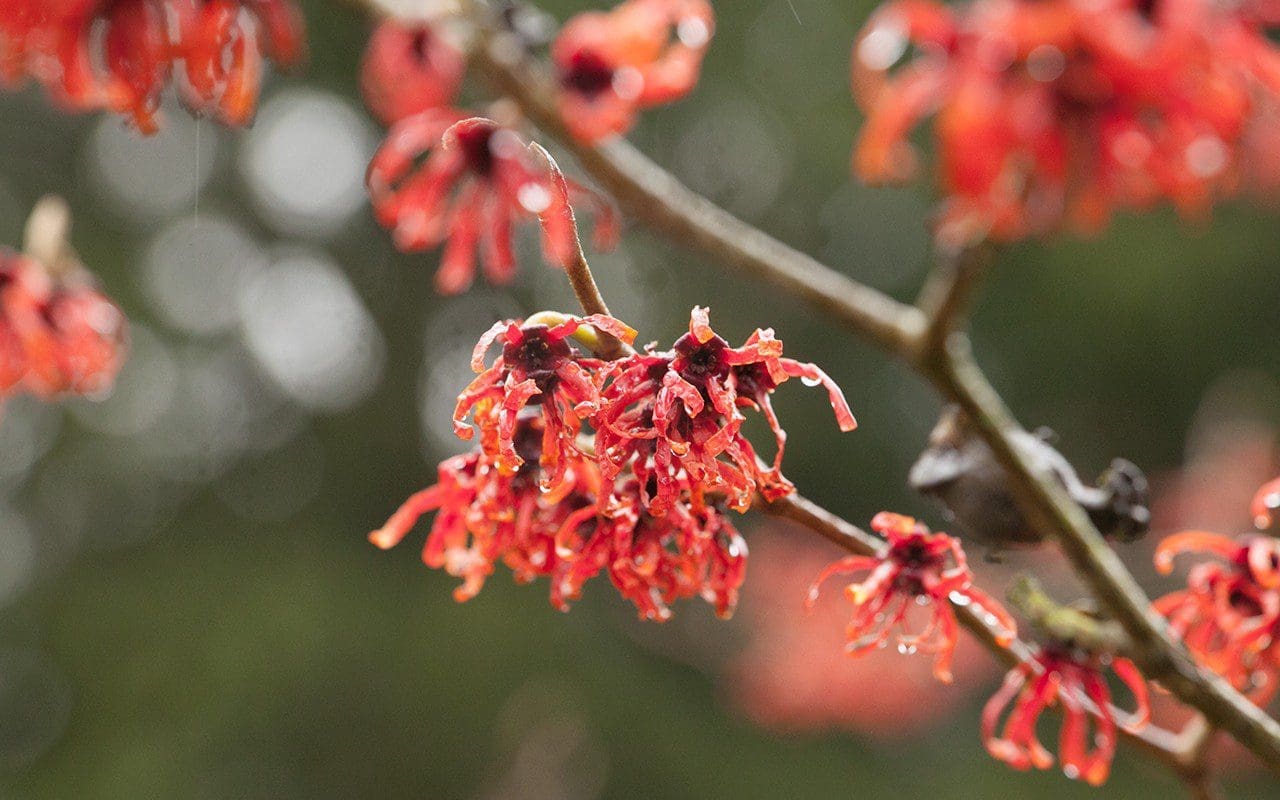 Hamamelis x intermedia ‘Diane’
Choosing the very best of a bewilderingly beautiful bunch is not easy, but my dabbling over the years has been worth it, for the named varieties have very differing habits. Being red-green colour blind, and losing some but not all reds, I must try hard to find ‘Diane’ when planted out in a garden. Up close I can see it is a wonderful colour and often use it for clients, but it is not one that I gravitate to for myself. It has a well-behaved, rounded habit and reliably scarlet autumn foliage, which singles it out as a variety to return to for two seasons of interest.
Several of the intermedia hybrids are problematic in my opinion for not losing leaves in winter, hanging on too long, like hornbeam or beech, to clutter what should be a naked stage of branches for the flowers. I have found that they do this in some gardens and not others and often they grow out of it as they mature, but I prefer the varieties that drop properly and most enjoy those that colour well in the autumn.
Hamamelis x intermedia ‘Diane’
Choosing the very best of a bewilderingly beautiful bunch is not easy, but my dabbling over the years has been worth it, for the named varieties have very differing habits. Being red-green colour blind, and losing some but not all reds, I must try hard to find ‘Diane’ when planted out in a garden. Up close I can see it is a wonderful colour and often use it for clients, but it is not one that I gravitate to for myself. It has a well-behaved, rounded habit and reliably scarlet autumn foliage, which singles it out as a variety to return to for two seasons of interest.
Several of the intermedia hybrids are problematic in my opinion for not losing leaves in winter, hanging on too long, like hornbeam or beech, to clutter what should be a naked stage of branches for the flowers. I have found that they do this in some gardens and not others and often they grow out of it as they mature, but I prefer the varieties that drop properly and most enjoy those that colour well in the autumn.
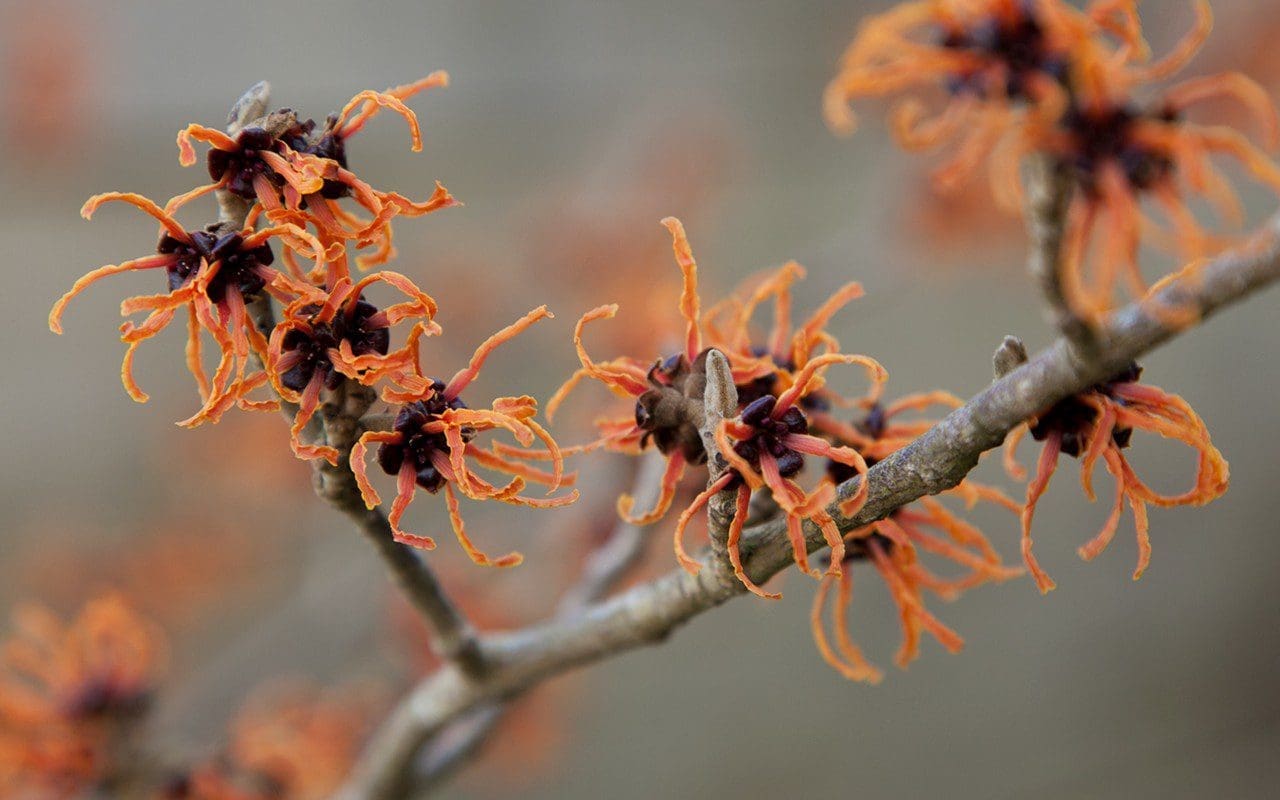 Hamamelis x intermedia ‘Gingerbread’
My plants here will be happy in our retentive loam despite the exposure, but I do mulch heavily with compost to emulate their natural wooded habitat. They have been planted here not only for the winter draw they provide, but also for the benefit of shade they bring to plants around them come summer. Rooting lightly and without heavy competition, they will provide home to spring flowering pulmonaria and erythronium which will come as they fade. The foliage of ‘Gingerbread’ has a copper flush as it comes into leaf, which is good with the Bath Asparagus planted beneath it, but later in the summer the branches provide a frame for Tropaeolum speciosum. The Flame Flower makes the branches flare again, when I have all but forgotten the winter spell that I am bewitched by today.
Words: Dan Pearson / Photographs: Huw Morgan
Published 27 January 2018
Hamamelis x intermedia ‘Gingerbread’
My plants here will be happy in our retentive loam despite the exposure, but I do mulch heavily with compost to emulate their natural wooded habitat. They have been planted here not only for the winter draw they provide, but also for the benefit of shade they bring to plants around them come summer. Rooting lightly and without heavy competition, they will provide home to spring flowering pulmonaria and erythronium which will come as they fade. The foliage of ‘Gingerbread’ has a copper flush as it comes into leaf, which is good with the Bath Asparagus planted beneath it, but later in the summer the branches provide a frame for Tropaeolum speciosum. The Flame Flower makes the branches flare again, when I have all but forgotten the winter spell that I am bewitched by today.
Words: Dan Pearson / Photographs: Huw Morgan
Published 27 January 2018 The Lonicera fragrantissima broke the first flower buds in the last week of December, closing the year with a perfumed offering on the cool air. At the moment, for this is still a young garden, it is one of the few flowers that brave the shortest days. Also flowering now is the witch hazel, Hamamelis x intermedia ‘Barmstedt Gold’. Its spidery yellow flowers have a light bergamot fragrance and some sprigs for the house are precious for their scarcity. Winter honeysuckle itself is an easy thing. Indeed, it will grow in the toughest of places on next to nothing. It was one of the solitary survivors amongst the undergrowth when I moved to the garden in Peckham almost twenty years ago. I dug it out, saving a layering to pass on and not erase it completely from memory. With limited space I wanted something more choice in its place back then and so enjoyed it vicariously in client’s gardens until we moved here and had room for it.
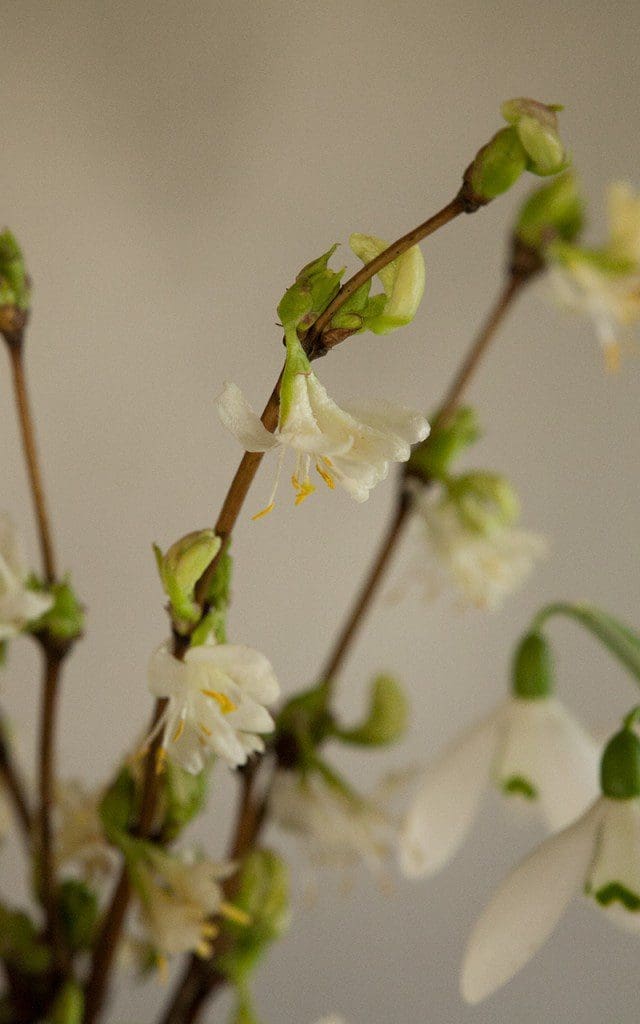 Lonicera fragrantissima
Lonicera fragrantissima
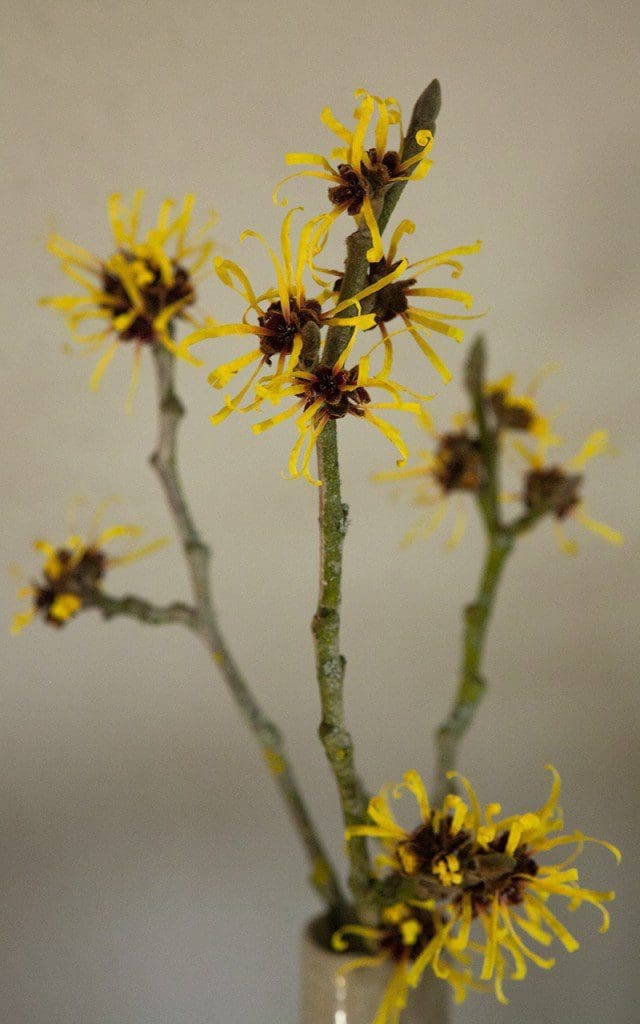 Hamamelis x intermedia ‘Barmstedt Gold’
Hamamelis x intermedia ‘Barmstedt Gold’
Though its ease of cultivation and eagerness to take its own territory, like lilac, is less welcome where space is limited, where you can afford to give it the opportunity to flourish, it is a thing to treasure. I’m pleased to have it at my fingertips for its refusal to bow to the season and have planted it at the end of the barns, on a rubbly mound where an aged bullace stands next to the compost heaps. Little grew there except nettles, but I saw in this leftover place a perfect position to let it take hold.
A little plant, from an easily taken cutting, went in two winters ago and it already has a presence, one arching limb bigger and more fully formed than the next and the flowers springing from the lateral growth of the previous year. It is never fully deciduous until the push of bright new leaves in the spring and the pale, waxy flowers are held amongst a scattering of yellowing foliage. Look closely and the blooms with their splayed yellow anthers are clearly those of honeysuckle and they smell like it too. I will leave the shrub to attain full size at 3 metres and not curtail it by regular pruning, although it responds well to the clippers and makes a fine scented hedge. In time I plan to remove whole branches and bring them into the house. Captured indoors the perfume is pervasive, but never overpowering like that of paperwhites.
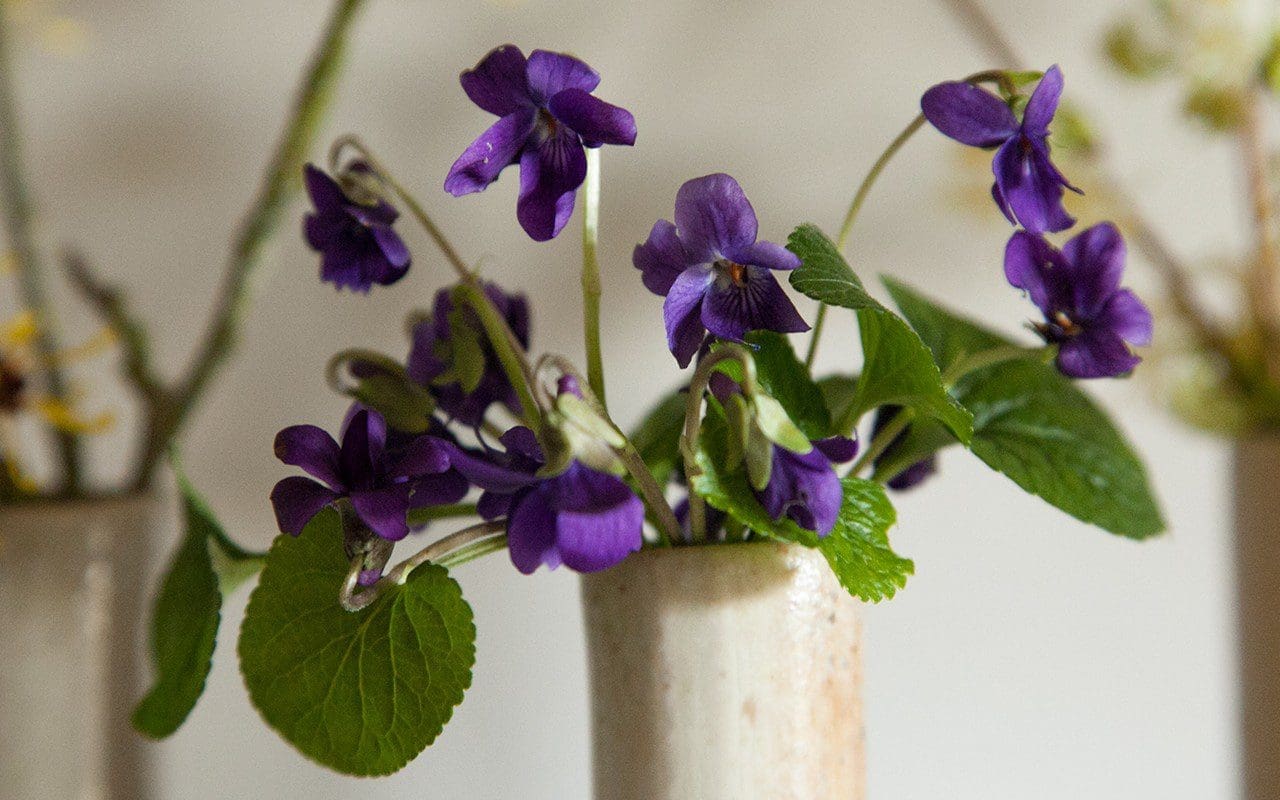 Viola odorata
Viola odorata
I have never quite fathomed why so many winter-flowering plants possess a perfume because, although the scent is designed to attract pollinators from a distance, the majority of insects are in hibernation when they are in flower. However, it is a lovely thing to come upon when you are expecting less. Placing is all important where these moments can be fugitive on winter air, and the perfume of the lonicera is held in the stillness around the barns. As it is hungry at the root I have planted a drift of Viola odorata at its base. I believe them to be florist’s violets from the time when the land here was a market garden. There was a self-seeded colony in the lawn in front of the house, which I saved when the re-landscaping took place last year. Rummage amongst the foliage and the very first flowers are already present, their inimitable powdery scent providing a foretaste of spring. Amongst the viola I am going to add one of the earliest of the snowdrops, Galanthus elwesii ‘Mrs. McNamara’, which also started flowering at the turn of the year and is sweetly scented of honey. Another layer to this winter collection and one that is always welcome at this fallow time.
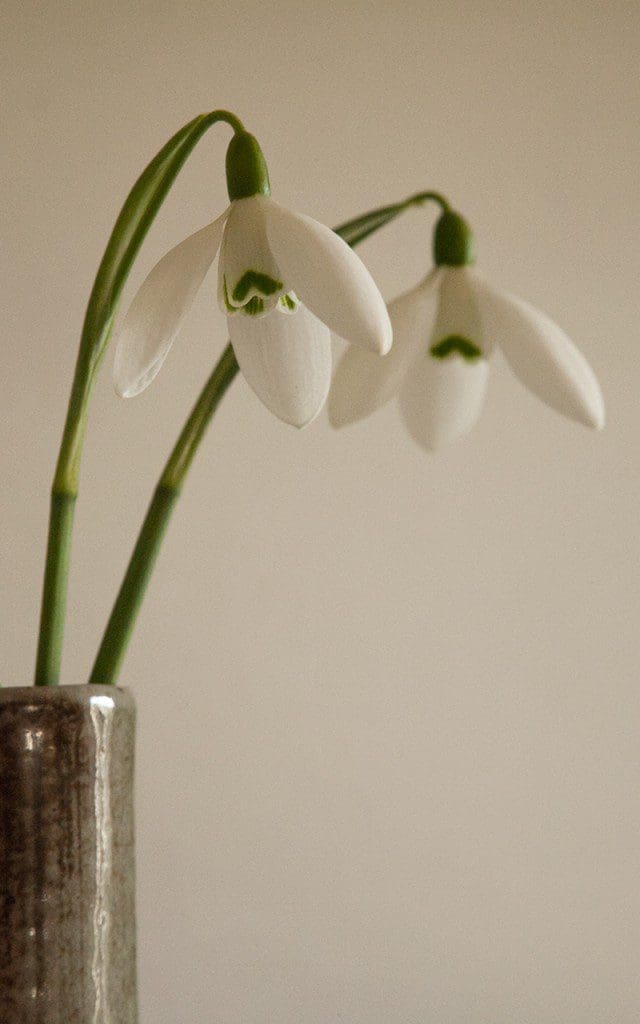 Galanthus elwesii ‘Mrs. McNamara’
Galanthus elwesii ‘Mrs. McNamara’
Words: Dan Pearson / Photographs: Huw Morgan
We are sorry but the page you are looking for does not exist. You could return to the homepage